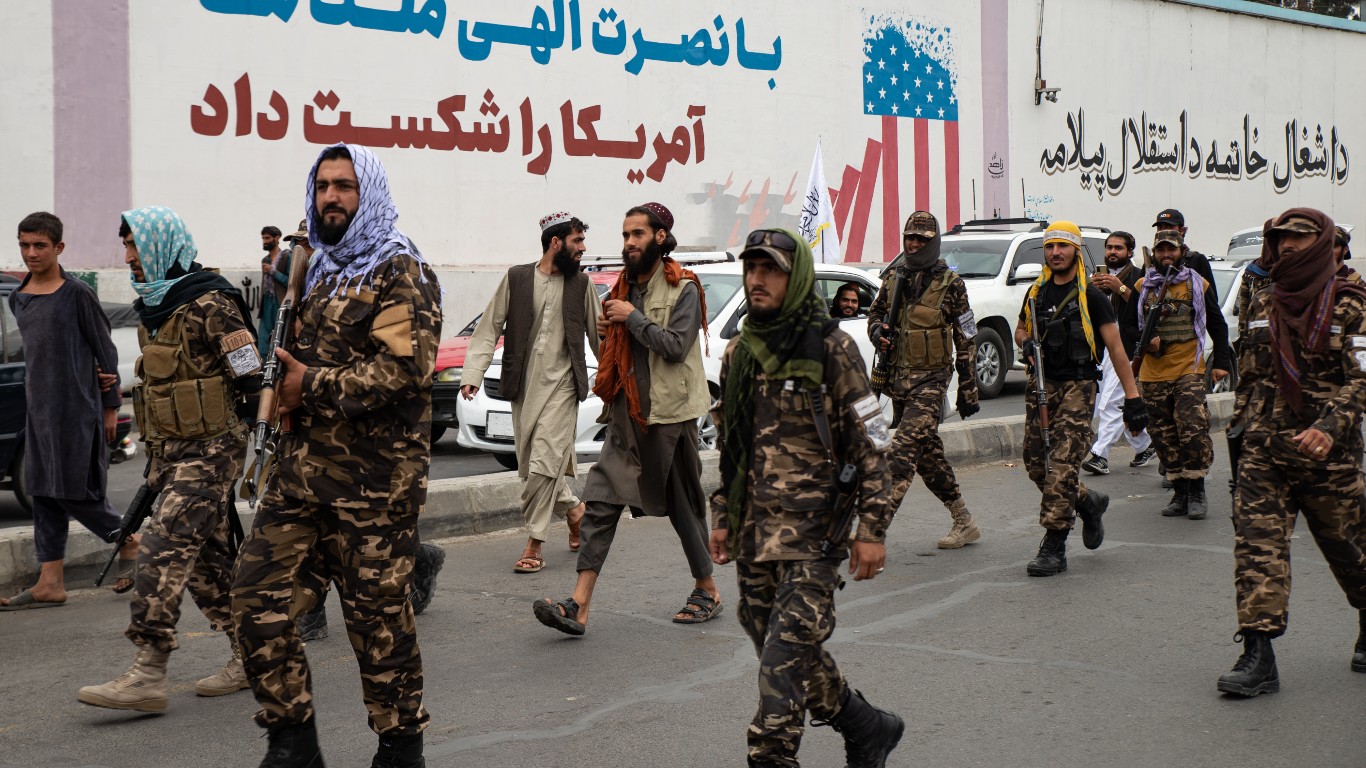
Homicides are rising at a record pace in the United States. According to a recent FBI report, there were a total of 21,570 murders committed in 2020, the most of any year in the last two and a half decades and up nearly 30% from 2019 — the largest annual increase on record.
The spike in homicides came during a tumultuous year. The COVID-19 pandemic shut down schools and left millions of Americans out of work. Footage of the murder of George Floyd by a Minneapolis police officer rattled confidence in American law enforcement and sparked nationwide protests. Firearms sales soared, and tens of millions of new guns proliferated across communities nationwide. Here is a look at the states where gun sales are surging.
Some experts speculate that each of these factors likely played a role in rising homicide rates nationwide. While it may be years before the precise causal factors are identified, many U.S. cities are bearing the brunt of the rash of deadly violence. In metropolitan areas across the country, the increase in homicides last year eclipsed the national surge — in some cases, many times over.
Using metro area-level data from the FBI, 24/7 Wall St. identified the major U.S. cities where homicide is soaring. We only considered metro areas with populations of at least 250,000 in our analysis.
Among the cities on this list, the number of murder cases surged anywhere from 40% to 500% between 2019 and 2020. Though these cities span the country, the largest share are concentrated in Midwestern states.
It is important to note that while murders are rising rapidly in each of the metro areas on this list, many of these places are still relatively safe. In fact, the majority of these cities have a lower overall violent crime rate than the national rate of 388 incidents per 100,000 people. Here is a look at America’s most dangerous states.
Click here to see large cities where homicide is soaring.
Click here to read our detailed methodology.

50. Tallahassee, FL
> Year-over-year increase in homicide: +40.0% (+10)
> 2020 homicide rate: 9.0 per 100,000 people (35 total murders)
> 2019 homicide rate: 6.5 per 100,000 people (25 total murders)
> 2020 violent crime rate: 555.7 per 100,000 people (2,157 total)
> Population: 388,159
A total of 35 homicides were reported in the Tallahassee, Florida, metro area in 2020, a 40% increase from the previous year’s total of 25. The increase was part of a broader trend of rising violence in Tallahassee, as the metro area’s overall violent crime rate climbed by over 6% last year.
Currently, the city’s murder rate of 9.0 homicides for every 100,000 people and violent crime rate of 556 per 100,000 are each well above the comparable national rates of 6.5 and 388 per 100,000, respectively.
[in-text-ad]
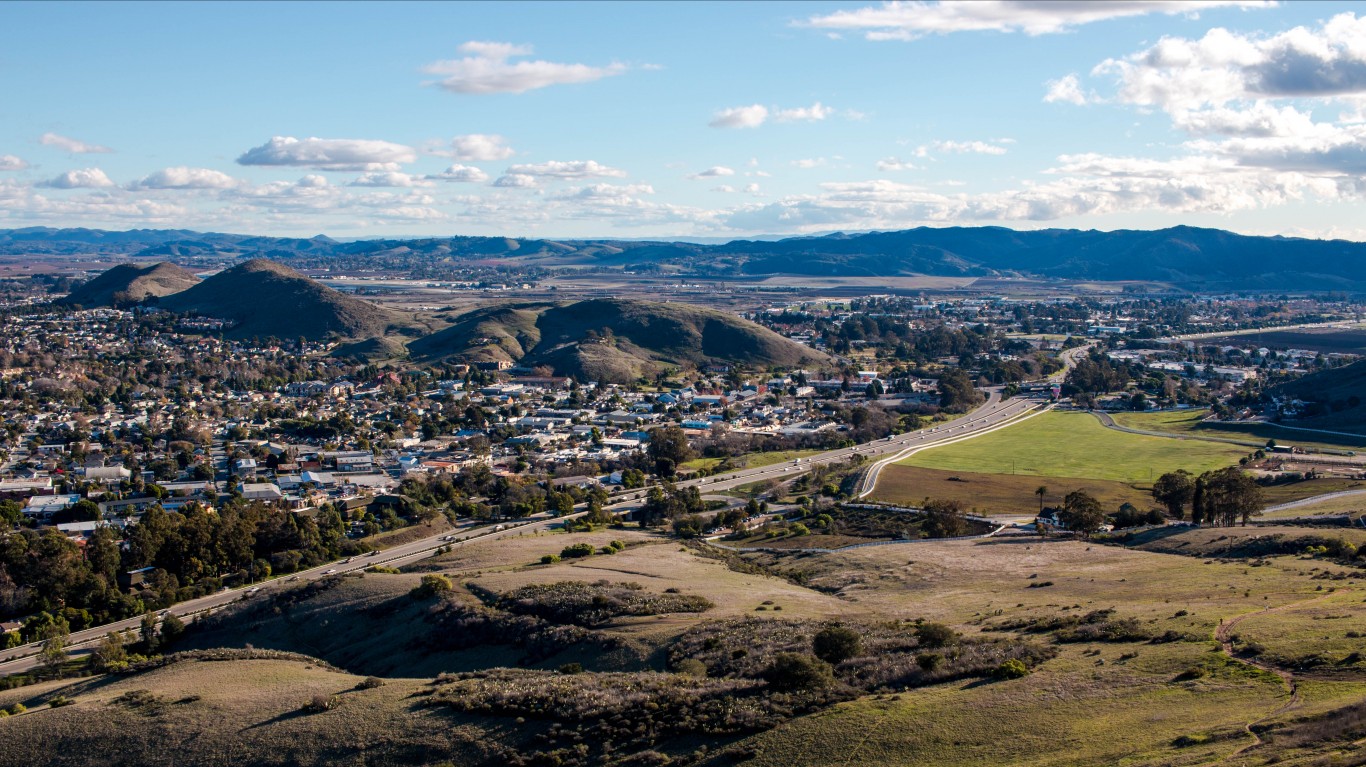
49. San Luis Obispo-Paso Robles, CA
> Year-over-year increase in homicide: +40.0% (+2)
> 2020 homicide rate: 2.5 per 100,000 people (7 total murders)
> 2019 homicide rate: 1.8 per 100,000 people (5 total murders)
> 2020 violent crime rate: 290 per 100,000 people (816 total)
> Population: 281,778
California’s San Luis Obispo metro area reported a 40% year-over-year increase in homicides. There were a total of seven murders reported in the area in 2020, up from five the previous year.
Murder was not the only violent crime that surged in San Luis Obispo last year. Aggravated assault, the most commonly reported violent crime reported in the United States, also climbed by 40.6% in the metro area. Some local law enforcement officials speculate that rising violence in the area is linked to inmates who were released in an effort to reduce jail and prison populations during the pandemic.

48. Rochester, NY
> Year-over-year increase in homicide: +42.1% (+16)
> 2020 homicide rate: 5.1 per 100,000 people (54 total murders)
> 2019 homicide rate: 3.6 per 100,000 people (38 total murders)
> 2020 violent crime rate: 262 per 100,000 people (2,782 total)
> Population: 1,061,736
Rochester is one of three metropolitan areas in New York state to report near nation-leading year-over-year increases in homicides. A total of 54 homicides were reported in the Rochester metro area in 2020, up 42.1% from 38 the previous year. Still, the local murder rate in the metro area of 5.1 homicides for every 100,000 people is below the national rate of 6.5 per 100,000.
Malik Evans, Democratic nominee and strong favorite in the city’s November 2021 mayoral election, attributes the increase to a number of growing problems, including illegal firearms, drug trafficking, and gang activity. So far this year, there has not been any sign of improvement as the city proper is on track for a record-high 70 homicides in 2021.
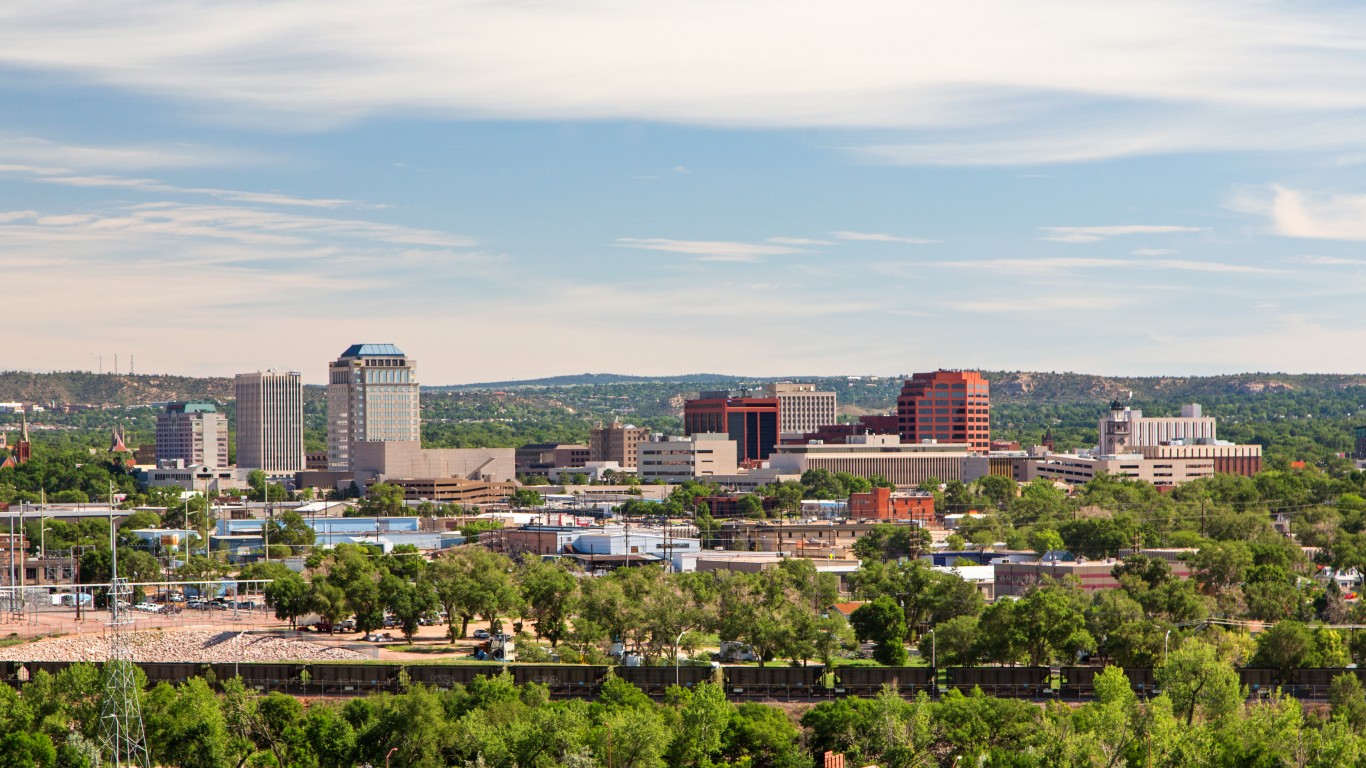
47. Colorado Springs, CO
> Year-over-year increase in homicide: +42.4% (+14)
> 2020 homicide rate: 6.2 per 100,000 people (47 total murders)
> 2019 homicide rate: 4.4 per 100,000 people (33 total murders)
> 2020 violent crime rate: 487 per 100,000 people (3,661 total)
> Population: 752,364
The Colorado Springs metro area reported 47 homicides in 2020, 14 more than the previous year. The 42.4% year-over-year increase in the number of homicides is the second highest of any large metro area in the state. Murders in the city last year were linked to a number of causes, including domestic violence and drug trafficking.
Colorado Springs has higher rates of violence overall than much of the rest of the country. There were a total of 487 violent crimes reported in the city for every 100,000 people in 2020, compared to the national violent crime rate of 388 per 100,000.
[in-text-ad-2]

46. Kingsport-Bristol, TN-VA
> Year-over-year increase in homicide: +42.9% (+6)
> 2020 homicide rate: 6.5 per 100,000 people (20 total murders)
> 2019 homicide rate: 4.6 per 100,000 people (14 total murders)
> 2020 violent crime rate: 364 per 100,000 people (1,116 total)
> Population: 306,891
A total of 20 murders were reported in the Kingsport-Bristol metro area in 2020, six more than were reported the year prior. Though the metro area’s 42.9% increase in homicides is higher than the national increase, the metro area’s murder rate of 6.5 homicides for every 100,000 people is in line with the national rate.
Other forms of violence, in addition to homicide, also surged in the Kingsport-Bristol metro area last year. Overall, the local violent crime rate climbed by 20.9% in 2020, four times the 5.2% year-over-year increase in violence nationwide.

45. Bridgeport-Stamford-Norwalk, CT
> Year-over-year increase in homicide: +42.9% (+12)
> 2020 homicide rate: 4.3 per 100,000 people (40 total murders)
> 2019 homicide rate: 3.0 per 100,000 people (28 total murders)
> 2020 violent crime rate: 164 per 100,000 people (1,522 total)
> Population: 928,567
The Bridgeport-Stamford-Norwalk metro area in Connecticut reported a 42.9% increase in the number of murders in 2020, the second highest of any major metropolitan area in New England. There were 40 homicides reported in the area in 2020, up from 28 in 2019.
Despite the surge in homicides, the metro area’s overall violent crime rate fell by nearly 6% last year, as reported cases of sexual assault, robbery, and aggravated assault all fell year over year. Additionally, the overall violent crime rate in Bridgeport of 164 incidents per 100,000 people is less than half the national violent crime rate of 388 per 100,000.
[in-text-ad]
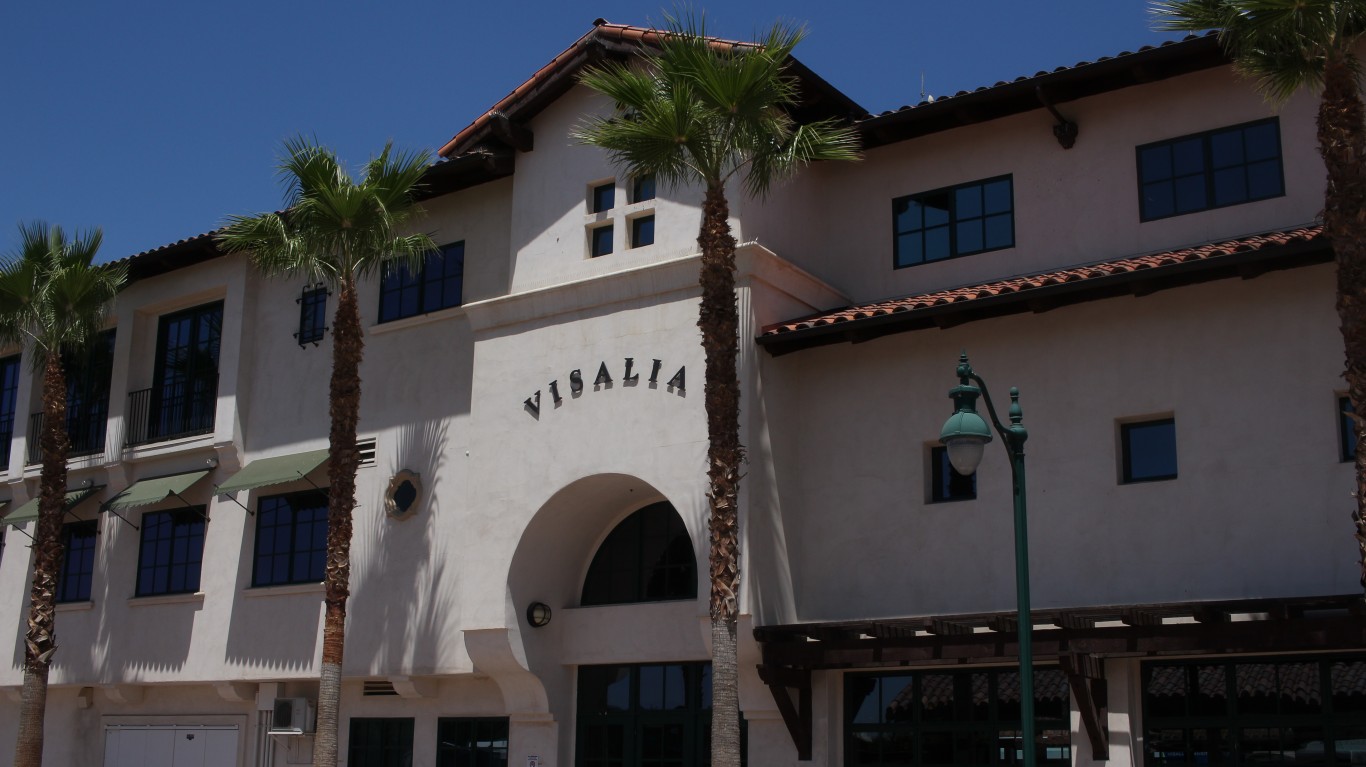
44. Visalia, CA
> Year-over-year increase in homicide: +45.0% (+9)
> 2020 homicide rate: 6.2 per 100,000 people (29 total murders)
> 2019 homicide rate: 4.3 per 100,000 people (20 total murders)
> 2020 violent crime rate: 366 per 100,000 people (1,699 total)
> Population: 464,150
There were a total of 29 murders reported in the Visalia, California, metro area in 2020, up 45% from the 20 murders reported in the area the previous year.
Though homicides surged in the city, other violent crimes increased only marginally, and due in part to an 8.5% drop in reported robberies, the overall violent crime rate remained effectively unchanged from the year before. The city’s violent crime rate of 366 incidents for every 100,000 people is slightly below the U.S. violent crime rate of 388 per 100,000.
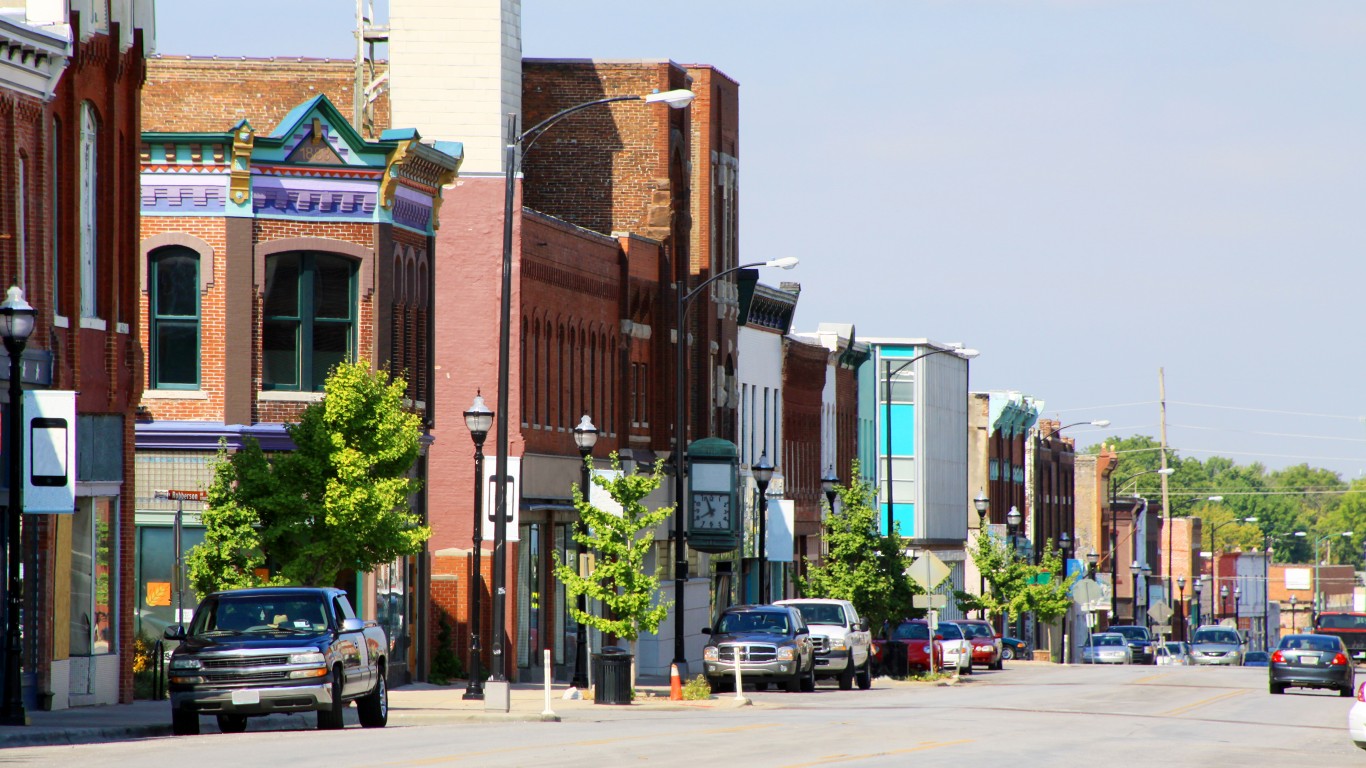
43. Springfield, MO
> Year-over-year increase in homicide: +52.9% (+9)
> 2020 homicide rate: 5.5 per 100,000 people (26 total murders)
> 2019 homicide rate: 3.6 per 100,000 people (17 total murders)
> 2020 violent crime rate: 632 per 100,000 people (2,993 total)
> Population: 473,913
Springfield, Missouri, is one of only 43 large metropolitan areas in the United States to report a more than 50% year-over-year increase in homicides. There were 26 murders in the metro area in 2020, up from 17 the previous year.
Local authorities have linked the surge in homicides to an increase in gun violence. Springfield residents are subject to few firearm restrictions, and the vast majority of homicides in the city in 2020 were carried out with a gun.

42. Tucson, AZ
> Year-over-year increase in homicide: +53.6% (+30)
> 2020 homicide rate: 8.1 per 100,000 people (86 total murders)
> 2019 homicide rate: 5.3 per 100,000 people (56 total murders)
> 2020 violent crime rate: 474 per 100,000 people (5,020 total)
> Population: 1,060,180
Murders rose at a rate of 53.6% in Tucson, Arizona, last year. A total of 86 homicides were reported in the metro area in 2020, up from 56 the previous year.
The trend of rising homicide rates will likely continue for the foreseeable future in Tucson. Preliminary reports show that 2021 may well prove to be a deadlier year in the city than 2020 was. In response, Tucson police are stepping up patrols in high-crime areas and reassigning robbery and assault officers to homicide cases. The vast majority of murders in the city — over 80% — have been solved.
[in-text-ad-2]

41. Ogden-Clearfield, UT
> Year-over-year increase in homicide: +55.6% (+5)
> 2020 homicide rate: 2.0 per 100,000 people (14 total murders)
> 2019 homicide rate: 1.3 per 100,000 people (9 total murders)
> 2020 violent crime rate: 173 per 100,000 people (1,197 total)
> Population: 692,112
The number of murders reported in the Ogden-Clearfield, Utah, metro area jumped by 55.6%, from nine in 2019 to 14 in 2020. Despite the increase, the local homicide rate remains far lower than average. The metro area’s murder rate currently stands at 2 incidents per 100,000 people, less than one-third the national murder rate of 6.5 incidents per 100,000.
While murders have surged in the metro area in the last year, some other forms of violence have not. The total number of all violent crimes reported in the area increased by just 2.6% in 2020 — below the 5.6% jump reported nationwide.

40. Toledo, OH
> Year-over-year increase in homicide: +55.6% (+20)
> 2020 homicide rate: 8.8 per 100,000 people (56 total murders)
> 2019 homicide rate: 5.6 per 100,000 people (36 total murders)
> 2020 violent crime rate: 486 per 100,000 people (3,108 total)
> Population: 639,977
Toledo is one of several large metropolitan areas in Ohio to report a substantial increase in homicides in 2020. There were 56 homicides reported in Toledo in 2020, a 55.6% increase from 36 homicides the previous year.
Violence in the metro area has continued into 2021. Local law enforcement officials attribute the problem to gang and drug activity. Combating the problem is also a growing challenge as low morale among city police is giving way to many officers taking jobs in smaller cities and others retiring early. The department is planning to add 90 more officers to the payroll by June 2022.
[in-text-ad]
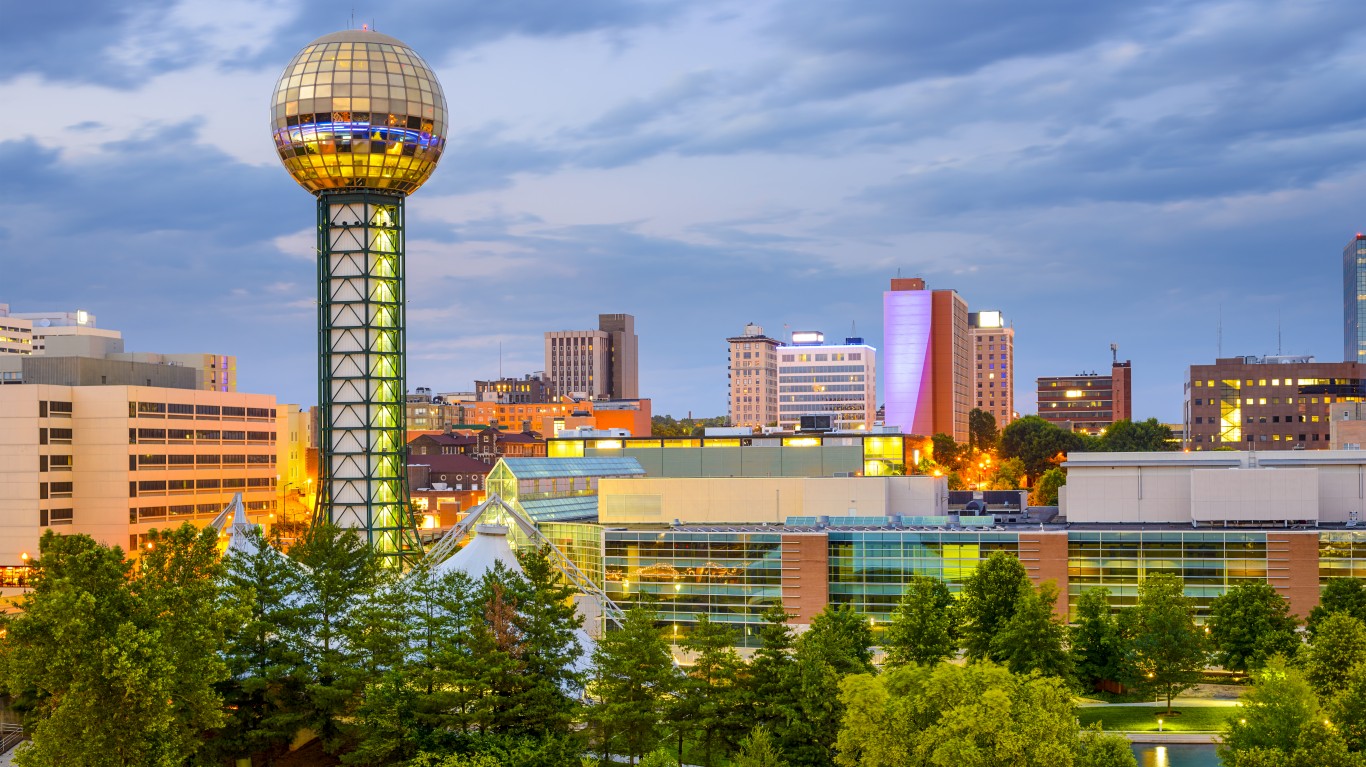
39. Knoxville, TN
> Year-over-year increase in homicide: +60.0% (+21)
> 2020 homicide rate: 6.4 per 100,000 people (56 total murders)
> 2019 homicide rate: 4.0 per 100,000 people (35 total murders)
> 2020 violent crime rate: 382 per 100,000 people (3,343 total)
> Population: 875,248
Homicides are up 60% year over year in Knoxville, Tennessee. There were 56 murders in the metro area in 2020, up from 35 the year prior. The total number of violent crimes reported in the metro area also increased by 9.1% over the same period. Still the city’s homicide rate of 6.4 per 100,000 and violent crime rate of 382 per 100,000 are closely in line with the 6.5 per 100,000 and 388 per 100,000 comparable national rates.
In order to address rising rates of violence in the city, Knoxville police were recently switched to 12-hour shifts, a move that is intended to maximize police presence on the streets.

38. Asheville, NC
> Year-over-year increase in homicide: +60.0% (+9)
> 2020 homicide rate: 5.1 per 100,000 people (24 total murders)
> 2019 homicide rate: 3.2 per 100,000 people (15 total murders)
> 2020 violent crime rate: 317 per 100,000 people (1,481 total)
> Population: 467,076
Homicides were up by 60% in the Asheville, North Carolina, metro area — from 15 murders reported in 2019 to 24 in 2020. Despite the spike, the metro area’s murder rate of 5.1 incidents per 100,000 people is lower than the 6.5 per 100,000 national murder rate.
The increase in homicides in the city is coinciding with a longer term trend of rising gun violence. There were 652 dispatch calls for shots fired in the city in 2020, up from 522 in 2019 and 401 in 2010.
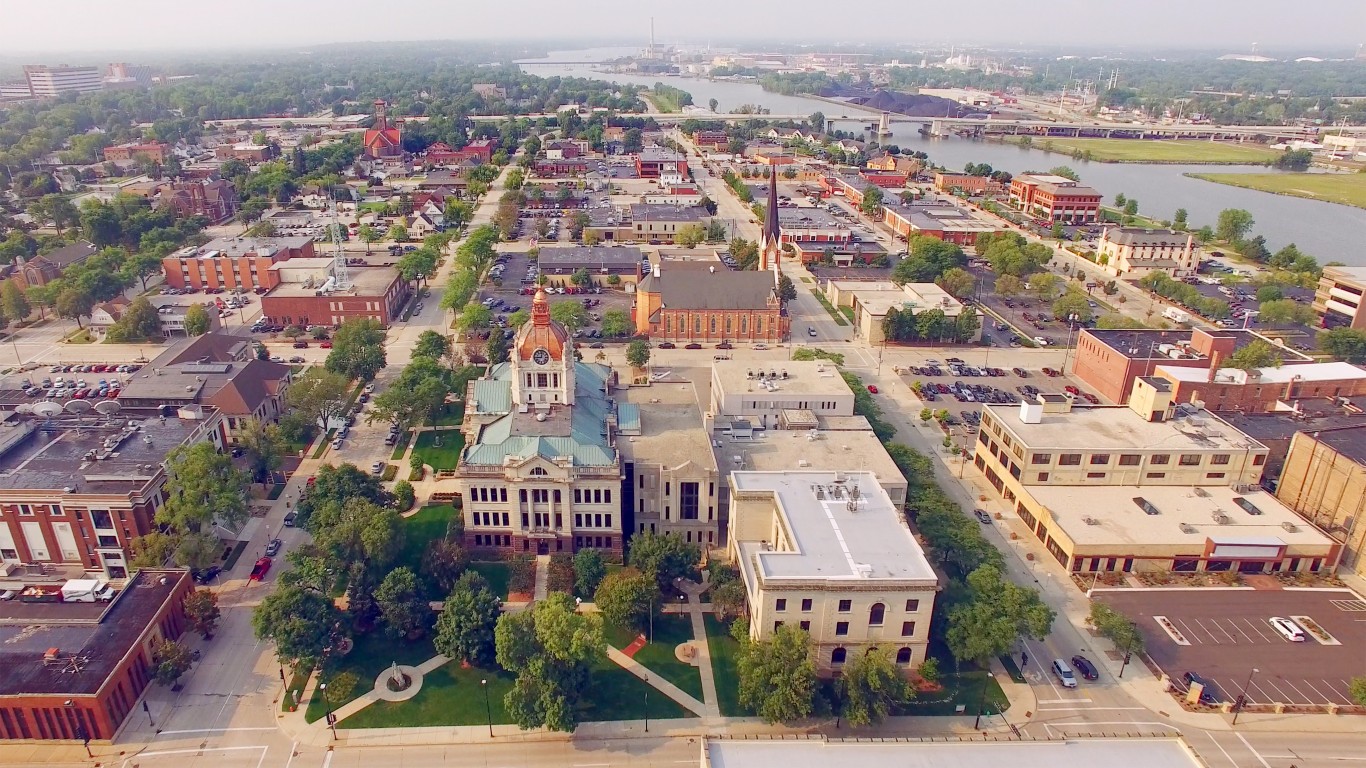
37. Green Bay, WI
> Year-over-year increase in homicide: +60.0% (+3)
> 2020 homicide rate: 2.5 per 100,000 people (8 total murders)
> 2019 homicide rate: 1.5 per 100,000 people (5 total murders)
> 2020 violent crime rate: 225 per 100,000 people (730 total)
> Population: 324,478
There were eight homicides reported in the Green Bay, Wisconsin, metropolitan area in 2020, up from five the previous year. Though there were fewer homicides in the area than in many other U.S. cities of similar size, and the local murder rate of 2.5 per 100,000 is well below the 6.5 per 100,000 national rate, the 60% year-over-year increase in homicides is far higher than in much of the rest of the country.
Though the number of homicides in the area spiked, reported cases of robbery and sexual assault, two other classifications of violent crime, fell considerably. Aggravated assault cases, meanwhile, increased slightly. Overall, the violent crime rate in Green Bay declined marginally in 2020.
[in-text-ad-2]

36. Salt Lake City, UT
> Year-over-year increase in homicide: +62.2% (+23)
> 2020 homicide rate: 4.8 per 100,000 people (60 total murders)
> 2019 homicide rate: 3.0 per 100,000 people (37 total murders)
> 2020 violent crime rate: 384 per 100,000 people (4,785 total)
> Population: 1,246,234
Homicides in the Salt Lake City metropolitan area surged by 62.2% last year. There were a total of 60 murders in the area in 2020, up from 37 in 2019. The trend shows no sign of slowing, as there have been more homicides in the city proper so far in 2021 than there were at the same point in 2020.
Amid the surge in violence and anti-police protests throughout 2020, nearly 60 Salt Lake City police officers left the force last year, and dozens have left this year. The job vacancies in the local police force have contributed to an increase in response times, from about 30 minutes in January 2021, to 49 minutes in May.

35. Kalamazoo-Portage, MI
> Year-over-year increase in homicide: +66.7% (+8)
> 2020 homicide rate: 7.5 per 100,000 people (20 total murders)
> 2019 homicide rate: 4.5 per 100,000 people (12 total murders)
> 2020 violent crime rate: 663 per 100,000 people (1,763 total)
> Population: 265,804
There were 20 homicides reported in the Kalamazoo, Michigan, metro area in 2020, a 66.7% increase from 12 the previous year. The city is one of several in the state to report a surge in homicide cases in the last year.
Rising rates of gun violence are contributing to the trend. All but one of the homicides reported in the city proper were carried out with a firearm, and the number of non-fatal shootings in the city doubled from 2019 to 2020. Gun violence shows no signs of slowing as shootings year to date are higher in 2021 than they were in 2020.
[in-text-ad]

34. Akron, OH
> Year-over-year increase in homicide: +66.7% (+22)
> 2020 homicide rate: 7.8 per 100,000 people (55 total murders)
> 2019 homicide rate: 4.7 per 100,000 people (33 total murders)
> 2020 violent crime rate: 378 per 100,000 people (2,659 total)
> Population: 702,634
Akron is one of several Ohio metro areas to report a surge in homicides. A total of 55 murders were reported in Akron in 2020, up 66.7% from 33 in 2019. Currently, the metro area’s homicide rate of 7.8 incidents per 100,000 people is considerably higher than the national rate of 6.5 per 100,000.
Local law enforcement say that feuds playing out on social media are fueling the surge in violence. So far this year, Akron police have taken nearly 600 guns off the street. But still, the homicide rate shows no sign of slowing in the city in 2021.

33. Stockton, CA
> Year-over-year increase in homicide: +68.0% (+34)
> 2020 homicide rate: 11.0 per 100,000 people (84 total murders)
> 2019 homicide rate: 6.6 per 100,000 people (50 total murders)
> 2020 violent crime rate: 723 per 100,000 people (5,517 total)
> Population: 763,250
Homicides in the Stockton, California, metropolitan area surged by 68% last year. There were a total of 84 murders in the area in 2020, up from 50 in 2019. Currently, the metro area’s homicide rate of 11 incidents per 100,000 people is far higher than the national rate of 6.5 per 100,000.
A local police spokesman attributed the increase, in part, to the COVID-19 pandemic, as homicides resulting from domestic disputes totalled 15 in the city proper last year, when in normal years, there are only one or two such murders. The vast majority of all homicides in Stockton last year involved firearms.

32. Columbus, OH
> Year-over-year increase in homicide: +69.9% (+79)
> 2020 homicide rate: 9.0 per 100,000 people (192 total murders)
> 2019 homicide rate: 5.3 per 100,000 people (113 total murders)
> 2020 violent crime rate: 313 per 100,000 people (6,718 total)
> Population: 2,145,231
Columbus is one of several Ohio metro areas to report a surge in homicides. A total of 192 murders were reported in Columbus in 2020, up 69.9% from 113 in 2019. Currently, the metro area’s homicide rate of 9.0 incidents per 100,000 people is considerably higher than the national rate of 6.5 per 100,000, while last year, Columbus’ homicide rate was closely in line with the 5.1 per 100,000 national rate.
Cases of aggravated assault also surged in Columbus in 2020, soaring by nearly 28%. The trend has not slowed in 2021, as the city is on pace to have its deadliest year on record. So far, only about half of the 147 murders reported in the city proper year to date have been solved.
[in-text-ad-2]

31. Cleveland-Elyria, OH
> Year-over-year increase in homicide: +72.1% (+88)
> 2020 homicide rate: 10.3 per 100,000 people (210 total murders)
> 2019 homicide rate: 5.9 per 100,000 people (122 total murders)
> 2020 violent crime rate: 441 per 100,000 people (9,002 total)
> Population: 2,042,966
Cleveland is one of only 31 large U.S. metro areas to report a greater than 70% increase in homicides last year. There were 210 murders reported in Cleveland in 2020, up from 122 in 2019. The homicide rate in Cleveland now stands at 10.3 for every 100,000 people, well above the 6.5 per 100,000 national rate.
City officials do not know what specifically is driving the spike but acknowledge that many homicides are connected to drug trafficking and gang activity.
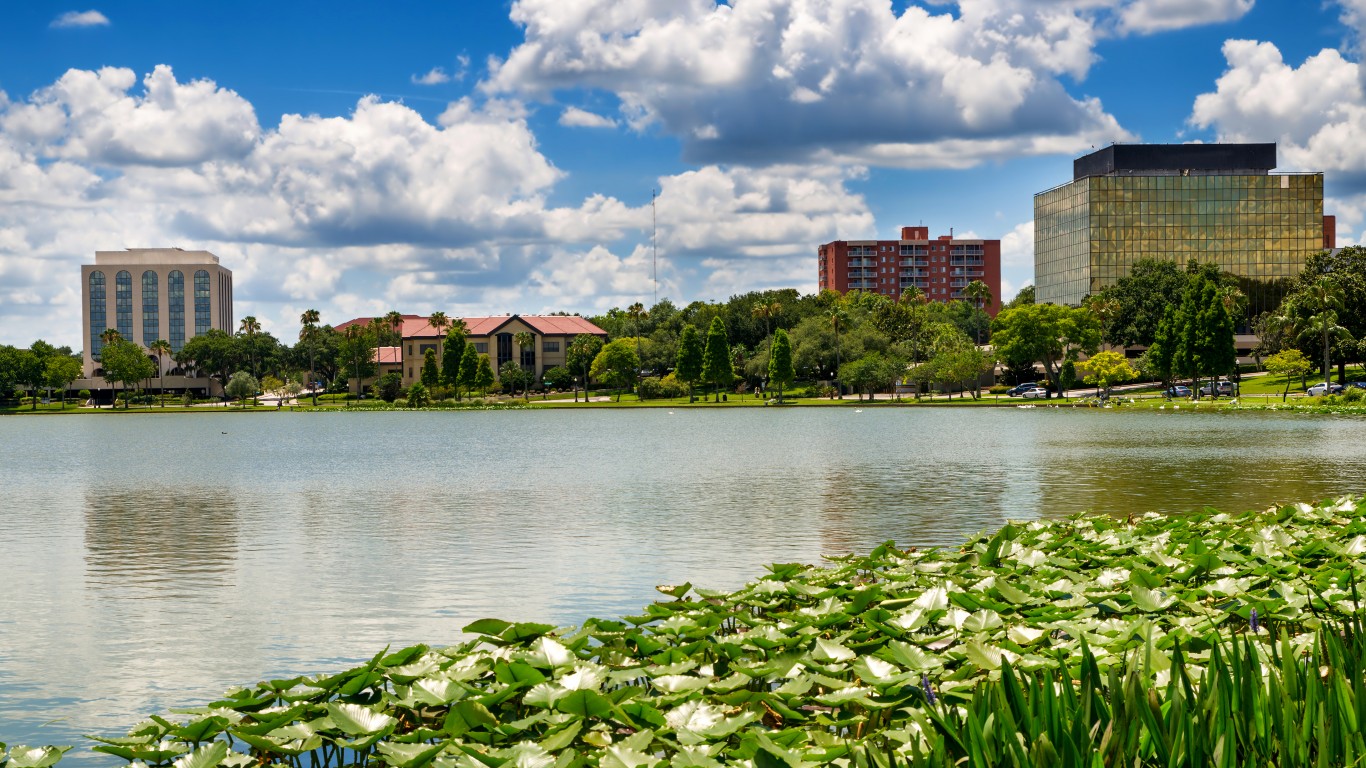
30. Lakeland-Winter Haven, FL
> Year-over-year increase in homicide: +73.9% (+17)
> 2020 homicide rate: 5.4 per 100,000 people (40 total murders)
> 2019 homicide rate: 3.2 per 100,000 people (23 total murders)
> 2020 violent crime rate: 287 per 100,000 people (2,115 total)
> Population: 737,548
There were 40 murders reported in the Lakeland-Winter Haven, Florida, metro area in 2020, up about 74% from 23 in 2019. Despite the increase, the local homicide rate of 5.4 incidents per 100,000 people is lower than the national rate of 6.5 per 100,000.
Local law enforcement officials attribute the increase, at least in part, to COVID-19, which limited law enforcement’s ability to meet face to face with community members.
[in-text-ad]

29. New Haven-Milford, CT
> Year-over-year increase in homicide: +75.0% (+21)
> 2020 homicide rate: 6.1 per 100,000 people (49 total murders)
> 2019 homicide rate: 3.5 per 100,000 people (28 total murders)
> 2020 violent crime rate: 256 per 100,000 people (2,049 total)
> Population: 799,461
The New Haven metro area in Connecticut reported a surge in violence in 2020 following years of relative stability. A total of 49 homicides were reported in the area in 2020, up 75% from 28 the previous year. The city also grappled with a surge in gun violence over the last year that contributed to 142 firearms taken off the streets and 144 gun crime arrests in the city proper.
Police officials identified several causal factors. As was the case in other parts of the county, COVID-19 limited the services local police provide to reduce violence. Additionally, a larger than average number of convicted felons were released to communities across the metro area this year — some because of the pandemic and others simply because their sentences were up.

28. Syracuse, NY
> Year-over-year increase in homicide: +75.0% (+15)
> 2020 homicide rate: 5.4 per 100,000 people (35 total murders)
> 2019 homicide rate: 3.1 per 100,000 people (20 total murders)
> 2020 violent crime rate: 304 per 100,000 people (1,953 total)
> Population: 642,895
Syracuse reported the second largest increase in homicide cases among large metro areas in New York state and the 28th largest increase nationwide. There were 35 homicides reported in the area in 2020, a 75% increase from 20 in 2019. Despite the large increase, Syracuse’s murder rate of 5.4 per 100,000 people remains lower than the 6.5 per 100,000 national murder rate.
According to a local police spokesperson, drug trafficking and gangs were common themes in many local homicides. COVID-19 was also directly linked to some murders and exacerbated other socioeconomic hardships in the city, like poverty. Syracuse’s poverty rate of 13.9% is slightly higher than the 12.3% national average.

27. Reno, NV
> Year-over-year increase in homicide: +80.0% (+12)
> 2020 homicide rate: 5.6 per 100,000 people (27 total murders)
> 2019 homicide rate: 3.2 per 100,000 people (15 total murders)
> 2020 violent crime rate: 463 per 100,000 people (2,238 total)
> Population: 483,469
There were 27 murders reported in the Reno, Nevada, metro area in 2020, up 80% from 15 murders the previous year — one of the largest increases of any large U.S. metropolitan area. Despite the significant increase, Reno’s murder rate of 5.6 per 100,000 people remains lower than the 6.5 per 100,000 national murder rate.
Violence shows no signs of slowing in Reno. In the first six months of 2021, there were 104 assaults and eight homicides in the city proper alone, nearly as many as there were in the whole of 2019.
[in-text-ad-2]

26. Rockford, IL
> Year-over-year increase in homicide: +80.0% (+16)
> 2020 homicide rate: 10.8 per 100,000 people (36 total murders)
> 2019 homicide rate: 6.0 per 100,000 people (20 total murders)
> 2020 violent crime rate: 771 per 100,000 people (2,566 total)
> Population: 332,940
Rockford, Illinois, is one of many Midwestern cities to report a surge in homicides year over year. There were 36 murders in the metro area in 2020, an 80% increase from 2019. The homicide rate in Rockford now stands at 10.8 for every 100,000 people, well above the 6.5 per 100,000 national rate.
The metro area also reported a 30% increase in cases of aggravated assault last year, which drove a 21% increase in overall violent crime. Currently, Rockford’s violent crime rate of 771 incidents per 100,000 people is well above the national rate of 388 per 100,000.

25. McAllen-Edinburg-Mission, TX
> Year-over-year increase in homicide: +84.2% (+16)
> 2020 homicide rate: 4.0 per 100,000 people (35 total murders)
> 2019 homicide rate: 2.2 per 100,000 people (19 total murders)
> 2020 violent crime rate: 275 per 100,000 people (2,408 total)
> Population: 876,280
McAllen-Edinburg-Mission, Texas, is one of only 25 large U.S. metro areas to report a more than an 80% year-over-year surge in homicides. The increase came as incidence of sexual assault and robbery fell. These declines were offset, however, by a 7.7% uptick in cases of aggravated assault, which drove a 2.7% overall increase in violent crime.
Despite the uptick in violence, the overall violent crime rate in the McAllen metro area stands at 275 incidents per 100,000 people, considerably lower than the U.S. violent crime rate of 388 per 100,000.
[in-text-ad]
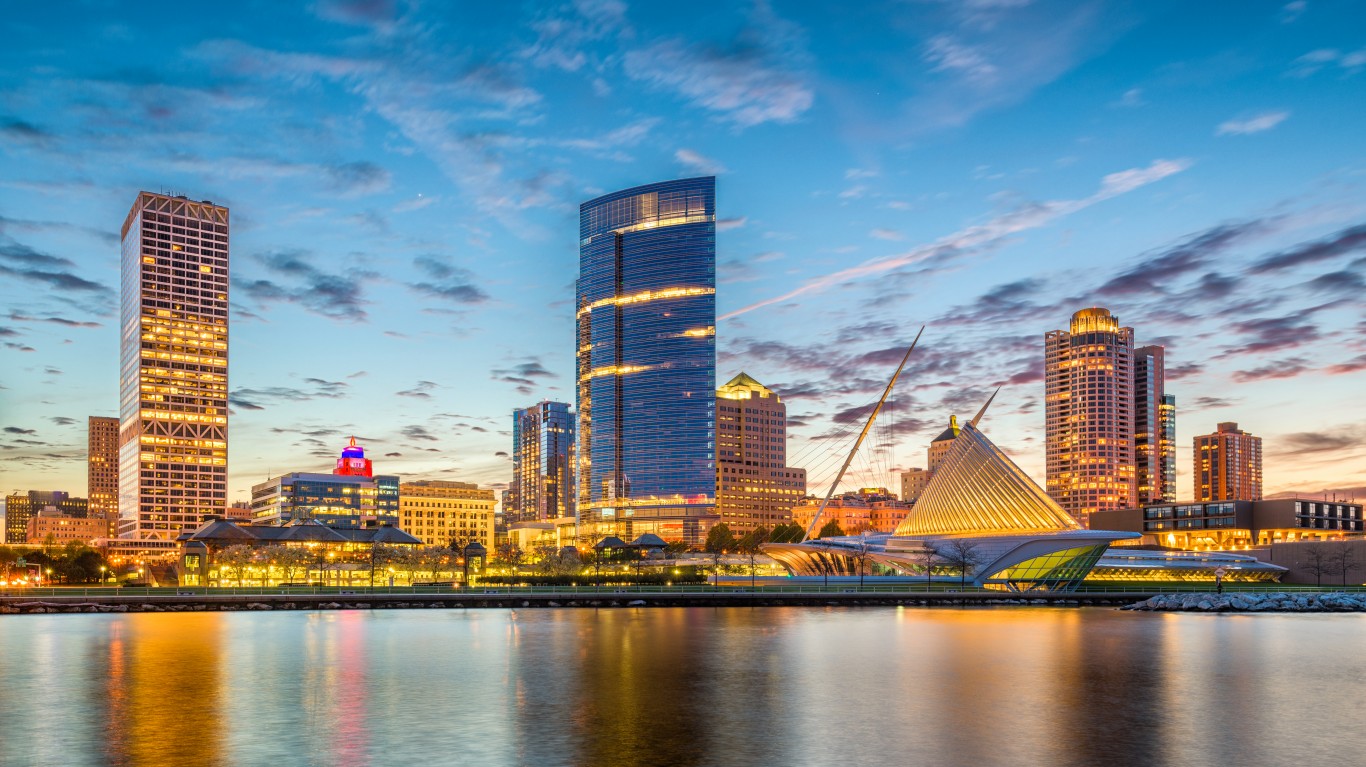
24. Milwaukee-Waukesha, WI
> Year-over-year increase in homicide: +85.6% (+95)
> 2020 homicide rate: 13.1 per 100,000 people (206 total murders)
> 2019 homicide rate: 7.0 per 100,000 people (111 total murders)
> 2020 violent crime rate: 678 per 100,000 people (10,688 total)
> Population: 1,575,891
There were 206 homicides reported in the Milwaukee metro area in 2020, up from 111 the previous year. The 85.6% spike in murders is the second highest among large Wisconsin metro areas and 24th highest nationwide.
The majority of homicides in Milwaukee proper in 2020 were committed in an area that, due to redlining and other racist housing policies, is both poor and predominantly Black. Some local officials connect the rising violence in the area to an influx of firearms and increased tensions between police and the communities they serve.

23. Vallejo, CA
> Year-over-year increase in homicide: +90.5% (+19)
> 2020 homicide rate: 8.9 per 100,000 people (40 total murders)
> 2019 homicide rate: 4.7 per 100,000 people (21 total murders)
> 2020 violent crime rate: 526 per 100,000 people (2,350 total)
> Population: 447,025
Homicides surged by over 90% in the Vallejo, California, metro area — from 21 in 2019 to 40 in 2020. As a result, the local homicide rate of 8.9 incidents per 100,000 people is now well above the 6.5 per 100,000 national rate. Vallejo’s 2019 homicide rate was 4.7 per 100,000 — slightly lower than the 5.1 per 100,000 national rate that year.
To combat rising violence, Vallejo police are requesting an additional 80 cameras to be deployed in high-crime areas. The proposal is receiving some pushback from the city council, however. Currently, there are 20 street cameras in use around Vallejo.
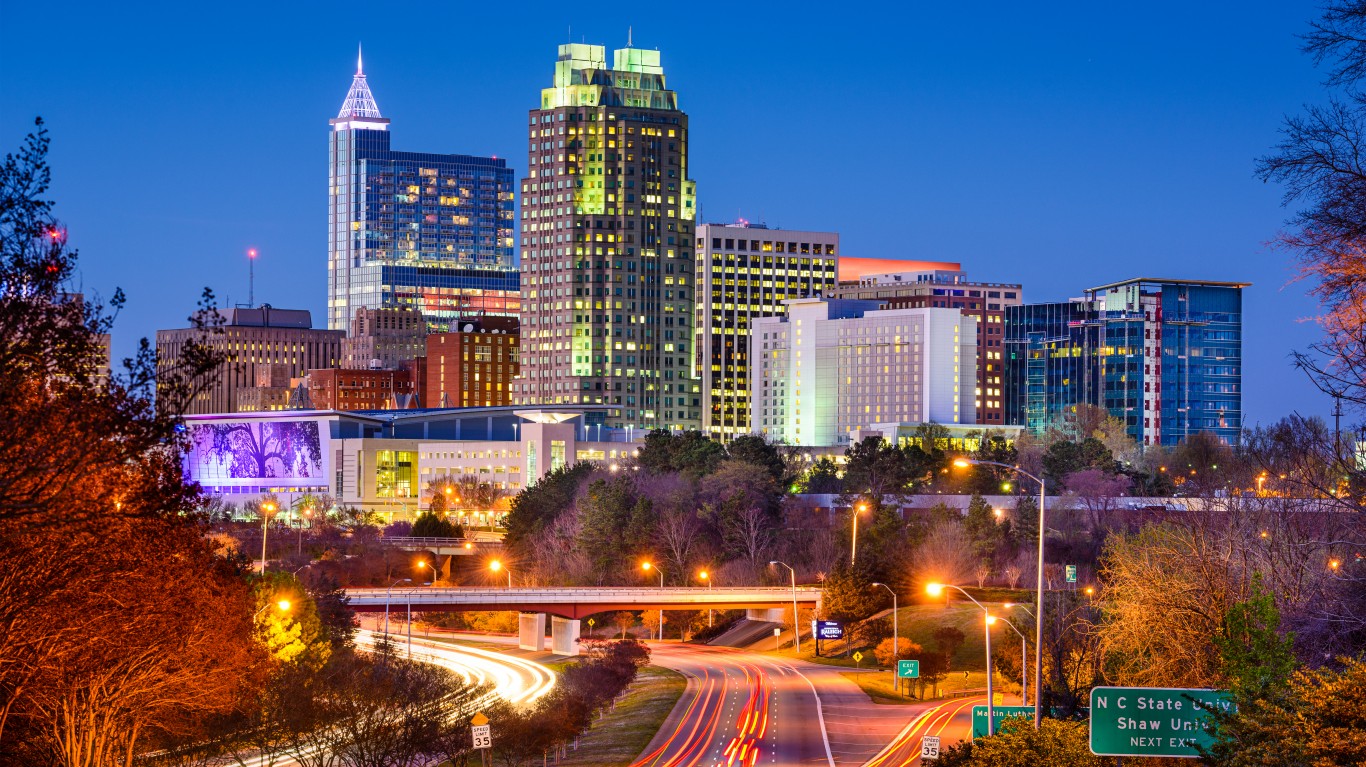
22. Raleigh-Cary, NC
> Year-over-year increase in homicide: +95.8% (+23)
> 2020 homicide rate: 3.3 per 100,000 people (47 total murders)
> 2019 homicide rate: 1.7 per 100,000 people (24 total murders)
> 2020 violent crime rate: 224 per 100,000 people (3,180 total)
> Population: 1,422,373
The number of homicides reported in the Raleigh, North Carolina, metro area has nearly doubled over the last year, from 24 in 2019 to 47 in 2020. Despite the increase, the metro area’s homicide rate of 3.3 incidents per 100,000 people remains lower than the 6.5 per 100,000 national increase.
As in many other American cities, the rise in homicide cases is occurring alongside rising gun violence — a trend that shows no signs of slowing so far in 2021. As of mid-September 2021, there were 600 crimes involving guns in Raleigh proper alone, up from 491 over the same period in 2020 and 480 in 2019.
[in-text-ad-2]

21. College Station-Bryan, TX
> Year-over-year increase in homicide: +100.0% (+5)
> 2020 homicide rate: 3.7 per 100,000 people (10 total murders)
> 2019 homicide rate: 1.9 per 100,000 people (5 total murders)
> 2020 violent crime rate: 298 per 100,000 people (799 total)
> Population: 268,082
College Station-Bryan, Texas, is one of 21 large U.S. metropolitan areas where homicide cases doubled or more last year. There were 10 murders reported in the metro area in 2020, up from five in 2019. The increase in homicides in the area came amidst a 15% annual increase in violent crimes overall.
Despite the recent trend, College Station-Bryan remains safer than much of the rest of the country. The local murder rate of 3.7 for every 100,000 people is well below the U.S. rate of 6.5 per 100,000, as is the overall violent crime rate of 298 per 100,000, which compares to the 388 per 100,000 national rate.
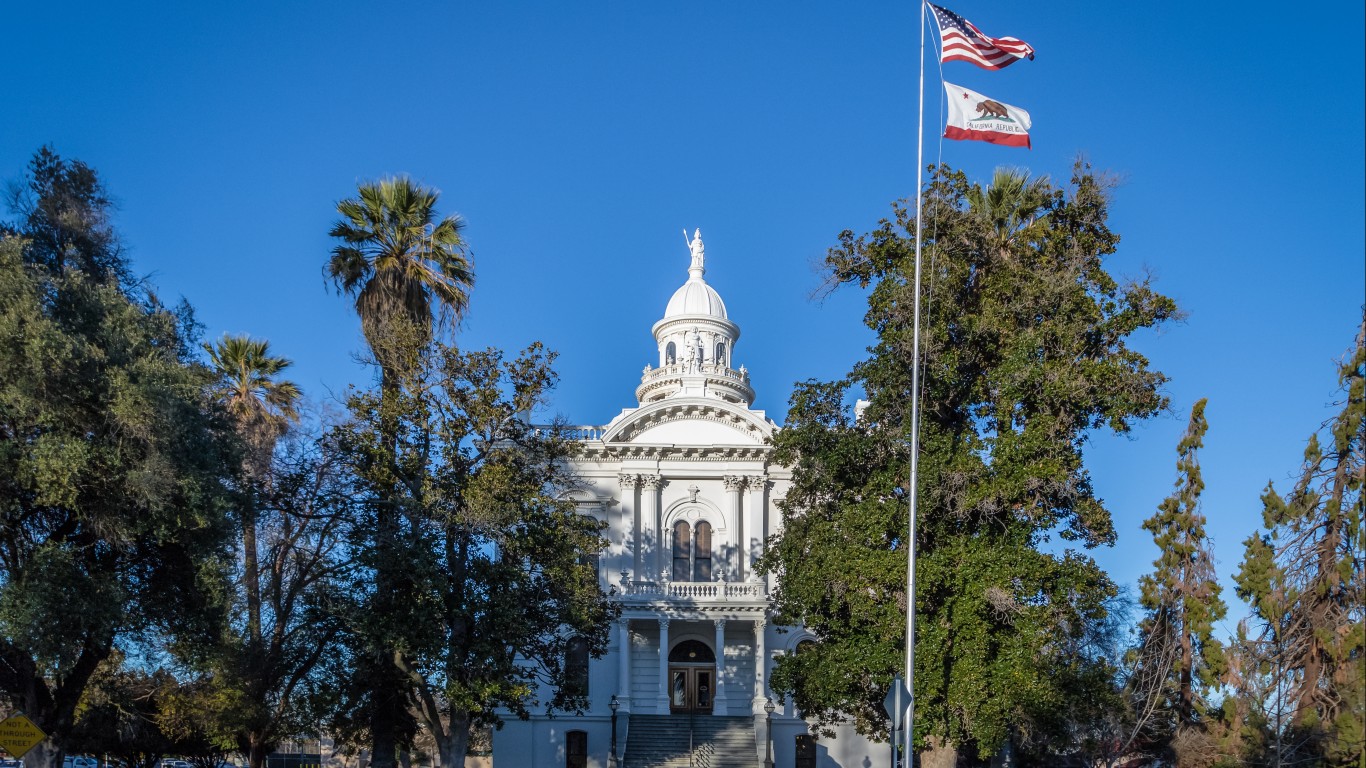
20. Merced, CA
> Year-over-year increase in homicide: +100.0% (+12)
> 2020 homicide rate: 8.7 per 100,000 people (24 total murders)
> 2019 homicide rate: 4.4 per 100,000 people (12 total murders)
> 2020 violent crime rate: 599 per 100,000 people (1,660 total)
> Population: 277,305
The Merced, California, metro area reported a total of 24 homicides in 2020, twice as many as the previous year. As a result, the local homicide rate of 8.7 incidents per 100,000 people is now well above the 6.5 per 100,000 national rate. Merced’s 2019 homicide rate of 4.4 per 100,000 was slightly lower than the 5.1 per 100,000 national rate that year.
All other types of violent crime — sexual assault, robbery, and aggravated assault — also climbed in Merced in 2020, though at a much lower rate than homicide. The metro area’s overall violent crime rate increased by 8.2% from 2019 to 2020, compared to the 5.2% national increase. Merced’s violent crime rate stands at 599 incidents for every 100,000 people, well above the U.S. rate of 388 per 100,000.
[in-text-ad]

19. Laredo, TX
> Year-over-year increase in homicide: +100.0% (+6)
> 2020 homicide rate: 4.3 per 100,000 people (12 total murders)
> 2019 homicide rate: 2.2 per 100,000 people (6 total murders)
> 2020 violent crime rate: 336 per 100,000 people (936 total)
> Population: 278,663
Laredo is one of five large Texas metro areas, and one of 21 nationwide, where the number of reported murders at least doubled last year. There were 12 homicides reported in Laredo in 2020, up from six in 2019. Despite the increase, the metro area’s homicide rate of 4.3 incidents per 100,000 people remains lower than the 6.5 per 100,000 national rate.
Meanwhile, cases of sexual assault and robbery declined in Laredo in 2020, contributing to an overall violent crime rate of 336 incidents for every 100,000 people, below the national rate of 388 per 100,000.

18. Santa Cruz-Watsonville, CA
> Year-over-year increase in homicide: +100.0% (+6)
> 2020 homicide rate: 4.4 per 100,000 people (12 total murders)
> 2019 homicide rate: 2.2 per 100,000 people (6 total murders)
> 2020 violent crime rate: 357 per 100,000 people (970 total)
> Population: 271,608
Along with Merced, Santa Cruz-Watsonville is one of two California metro areas where homicide cases doubled in the last year. There were 12 murders reported in Santa Cruz-Watsonville in 2020, up from six in 2019.
Amid the surge in homicides, incidents of all other forms of violent crime — sexual assault, robbery, and aggravated assault — declined. As a result, the metro area’s overall violent crime rate of 357 for every 100,000 people is nearly 12% lower than it was in 2019, despite the increase in murder cases.

17. Shreveport-Bossier City, LA
> Year-over-year increase in homicide: +107.3% (+44)
> 2020 homicide rate: 21.6 per 100,000 people (85 total murders)
> 2019 homicide rate: 10.4 per 100,000 people (41 total murders)
> 2020 violent crime rate: 683 per 100,000 people (2,683 total)
> Population: 392,827
The number of homicides reported in the Shreveport-Bossier City, Louisiana, metro area more than doubled last year, from 41 in 2019 to 85 in 2020. The local murder rate now stands at 21.6 homicides for every 100,000 people, among the highest of any U.S. metro area and well above the 6.5 per 100,000 U.S. homicide rate.
Violence in the area has continued to surge into 2021, prompting Shreveport’s chief of police to step down following a vote of no confidence from the city council. Local experts claim that the pandemic has exacerbated existing socioeconomic problems, like poverty, that are linked to crime. An estimated 22.2% of metro area residents live below the poverty line, compared to 12.3% of all Americans.
[in-text-ad-2]

16. Grand Rapids-Kentwood, MI
> Year-over-year increase in homicide: +108.3% (+26)
> 2020 homicide rate: 4.6 per 100,000 people (50 total murders)
> 2019 homicide rate: 2.2 per 100,000 people (24 total murders)
> 2020 violent crime rate: 350 per 100,000 people (3,793 total)
> Population: 1,083,395
Homicide cases jumped by over 108% in the Grand Rapids, Michigan, metro area, from 24 in 2019 to 50 in 2020. Despite the increase, the local homicide rate of 4.6 per 100,000 people remains below the 6.5 per 100,000 national rate.
For Grand Rapids proper, 2020 will go down as the deadliest year in the city’s history to date. The overall violent crime rate climbed by about 9% across the metro area last year, and the Grand Rapids Police Department took an average of 360 911 calls per day.

15. Canton-Massillon, OH
> Year-over-year increase in homicide: +111.1% (+10)
> 2020 homicide rate: 4.8 per 100,000 people (19 total murders)
> 2019 homicide rate: 2.3 per 100,000 people (9 total murders)
> 2020 violent crime rate: 366 per 100,000 people (1,451 total)
> Population: 396,284
Canton-Massillon is the only large Ohio metro area where homicide cases doubled in the last year. There were a total of 19 homicides reported in the area in 2020, up from nine in 2019. Despite the increase, the local homicide rate of 4.8 per 100,000 people remains below the national rate of 6.5 per 100,000.
Despite a decline in the number of reported rapes and robberies in the metro area last year, the overall violent crime rate climbed by 8.1%, driven up not only by the increase in homicides, but also a 16% jump in cases of aggravated assaults. Still, the overall violent crime rate in the Canton-Massillon metro area of 366 per 100,000 people is slightly below the national rate of 388 per 100,000.
[in-text-ad]
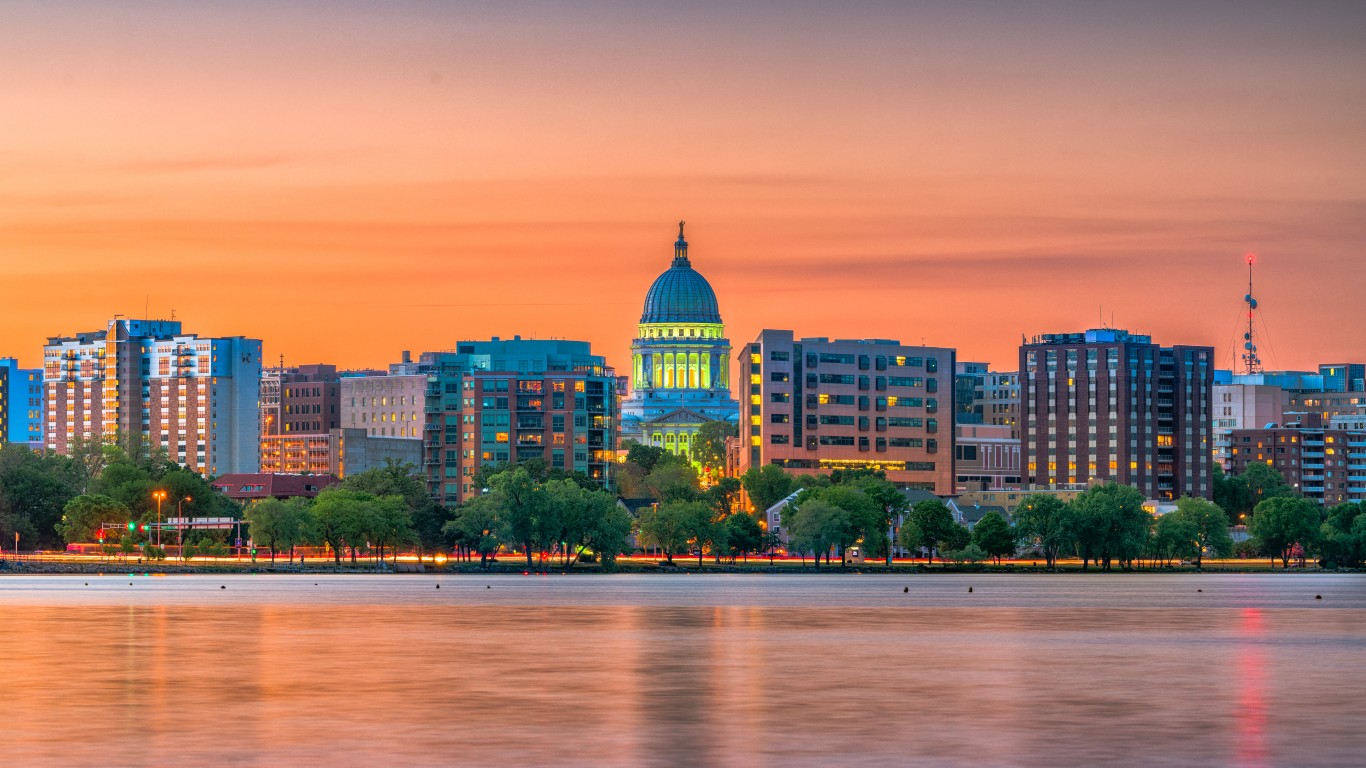
14. Madison, WI
> Year-over-year increase in homicide: +112.5% (+9)
> 2020 homicide rate: 2.5 per 100,000 people (17 total murders)
> 2019 homicide rate: 1.2 per 100,000 people (8 total murders)
> 2020 violent crime rate: 202 per 100,000 people (1,354 total)
> Population: 671,149
Madison, Wisconsin, reported the greatest increase in homicides of any large metro area in the state and 14th highest increase nationwide in 2020. There were 17 homicides reported in the metro area in 2020, up 112.5% from eight in 2019. The surge in homicide cases came alongside an increase in overall gun violence in Madison.
Despite the spike in gun violence and homicide, all other types of violent crime declined in the metro area in 2020, contributing to a 7.4% reduction in the local violent crime rate, which, at 202 incidents per 100,000 people, is well below the national rate of 388 per 100,000.

13. Spokane-Spokane Valley, WA
> Year-over-year increase in homicide: +130.8% (+17)
> 2020 homicide rate: 5.2 per 100,000 people (30 total murders)
> 2019 homicide rate: 2.3 per 100,000 people (13 total murders)
> 2020 violent crime rate: 350 per 100,000 people (2,005 total)
> Population: 572,842
There were a total of 30 homicides reported in the Spokane, Washington, metro area in 2020, up from 13 in 2019. The 131% increase is higher than in all but a dozen large U.S. metropolitan areas.
Despite the spike in homicides, all other types of violent crime declined in the Spokane metro area in 2020, contributing to a 8.1% reduction in the local violent crime rate. At 350 incidents per 100,000 people, the area’s violent crime rate is below the national rate of 388 per 100,000.

12. Trenton-Princeton, NJ
> Year-over-year increase in homicide: +141.2% (+24)
> 2020 homicide rate: 11.2 per 100,000 people (41 total murders)
> 2019 homicide rate: 4.6 per 100,000 people (17 total murders)
> 2020 violent crime rate: 359 per 100,000 people (1,316 total)
> Population: 367,006
The Trenton-Princeton, New Jersey, metro area reported a total of 41 homicides in 2020, a 141% increase from the previous year. As a result, the local homicide rate of 11.2 incidents per 100,000 people is now well above the 6.5 per 100,000 national rate, while Trenton’s 2019 homicide rate of 4.6 per 100,000 was slightly lower than the 5.1 per 100,000 national rate that year.
For Trenton proper, 2020 will go down as the deadliest year in the city’s history to date. The city’s mayor attributes the spike in homicides to the pandemic, which closed schools, put people out of work, and contributed to escalated tensions in parts of the city.
[in-text-ad-2]
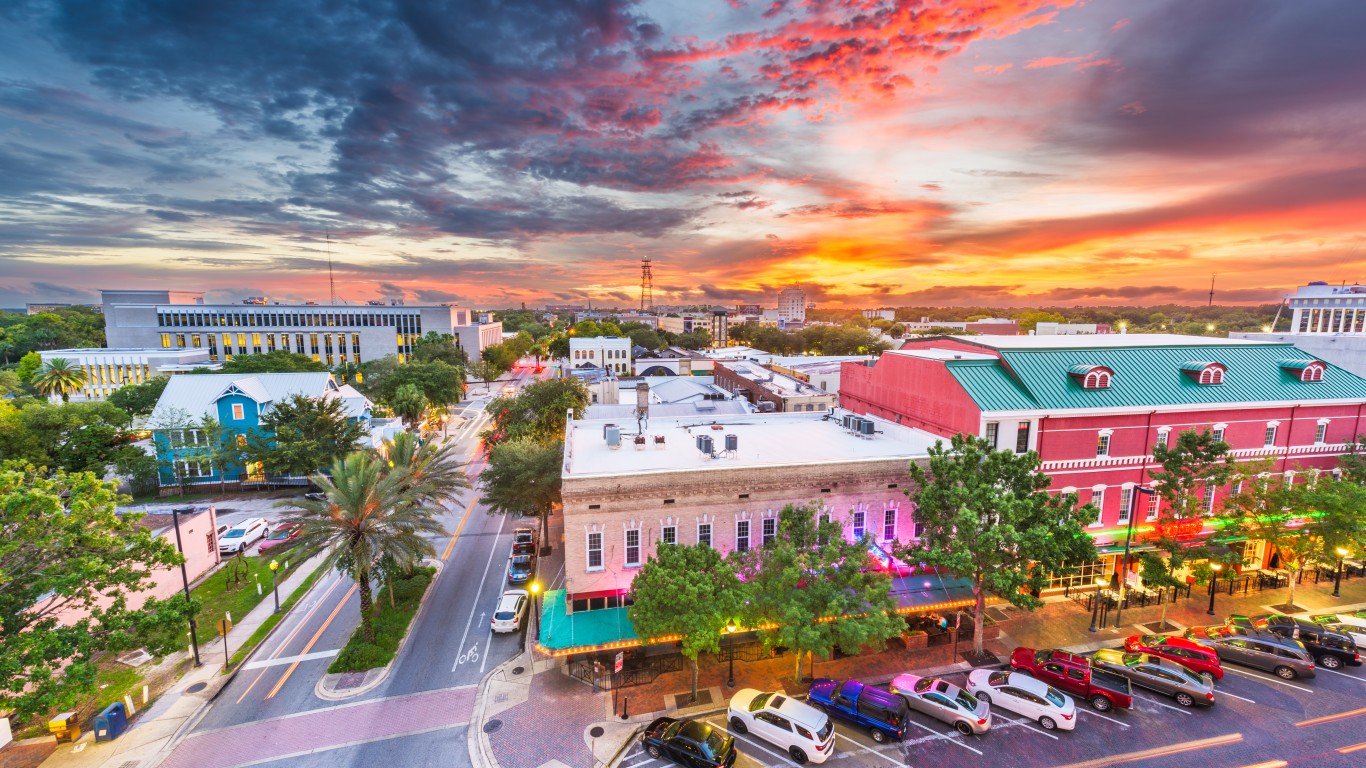
11. Gainesville, FL
> Year-over-year increase in homicide: +142.9% (+10)
> 2020 homicide rate: 5.1 per 100,000 people (17 total murders)
> 2019 homicide rate: 2.1 per 100,000 people (7 total murders)
> 2020 violent crime rate: 760 per 100,000 people (2,516 total)
> Population: 330,910
Gainesville, Florida, reported a 143% surge in homicides in the last year, the highest increase of any large metro area in the state and 11th highest nationwide. There were a total of 17 murders in Gainesville in 2020, up from seven in 2019.
In addition to a spike in murders, Gainesville also reported an uptick in robberies and aggravated assault cases in 2020, which contributed to a 9.9% increase in the metro area’s overall violent crime rate. There were 760 violent crimes for every 100,000 people in Gainesville in 2020, well above the U.S. violent crime rate of 388 per 100,000.

10. Albany-Schenectady-Troy, NY
> Year-over-year increase in homicide: +142.9% (+20)
> 2020 homicide rate: 3.9 per 100,000 people (34 total murders)
> 2019 homicide rate: 1.6 per 100,000 people (14 total murders)
> 2020 violent crime rate: 272 per 100,000 people (2,386 total)
> Population: 875,848
The Albany-Schenectady-Troy metro area in New York reported a 143% surge in homicides in 2020, more than any other large metropolitan area in the state and 10th highest nationwide. There were a total of 34 homicides in the area last year, up from 14 in 2019. Despite the increase, the local homicide rate of 3.9 per 100,000 people remains below the national rate of 6.5 per 100,000.
The three cities that comprise the metro area are splitting $2 million in state funds to combat the rash of violence. The program will target at-risk residents in the 18-24 age range and connect them with job training and career placement services.
[in-text-ad]

9. Flint, MI
> Year-over-year increase in homicide: +150.0% (+45)
> 2020 homicide rate: 18.6 per 100,000 people (75 total murders)
> 2019 homicide rate: 7.4 per 100,000 people (30 total murders)
> 2020 violent crime rate: 578 per 100,000 people (2,324 total)
> Population: 402,374
Flint, Michigan, is facing a surge of deadly violence unlike nearly anywhere else in the country. The metro area reported 75 total homicides in 2020 — a 150% increase from the previous year. The local murder rate now stands at 18.6 incidents for every 100,000 people, among the highest of any U.S. metro area and well above the 6.5 per 100,000 U.S. homicide rate.
Levels of violence have continued to climb in 2021. By mid-July, the city of Flint reported a 30% increase in homicides compared to the same period in 2020, and an 80% increase in non-fatal shootings. Escalating violence has triggered alarm in city hall and prompted the mayor to declare a state of emergency and take any and all necessary action to address the problem.
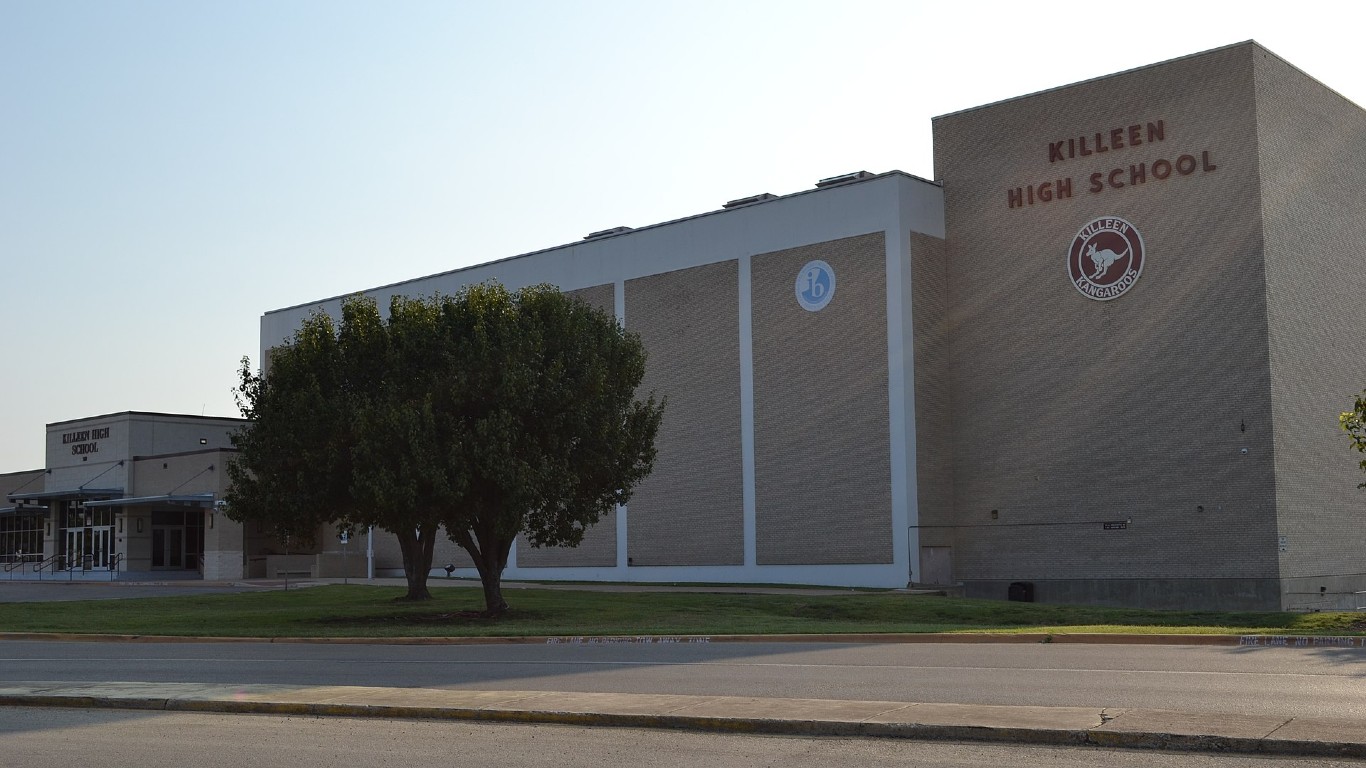
8. Killeen-Temple, TX
> Year-over-year increase in homicide: +152.6% (+29)
> 2020 homicide rate: 10.3 per 100,000 people (48 total murders)
> 2019 homicide rate: 4.2 per 100,000 people (19 total murders)
> 2020 violent crime rate: 377 per 100,000 people (1,754 total)
> Population: 464,991
The Killeen-Temple metro area is one of three in large Texas metro areas where homicides have more than doubled in the last year. There were 48 total murders reported in the city in 2020, a 153% increase from 19 in 2019. As a result, the local homicide rate of 10.3 incidents per 100,000 people is now well above the 6.5 per 100,000 national rate, while in 2019, the metro area’s homicide rate of 4.2 per 100,000 was below the 5.1 per 100,000 national rate that year.
In addition to homicides, the Killeen-Temple metro area reported a 75% jump in cases of aggravated assault. These increases contributed to a 42.7% increase in the overall violent crime rate, which, at 377 incidents per 100,000 people is slightly below the national rate of 388 per 100,000.
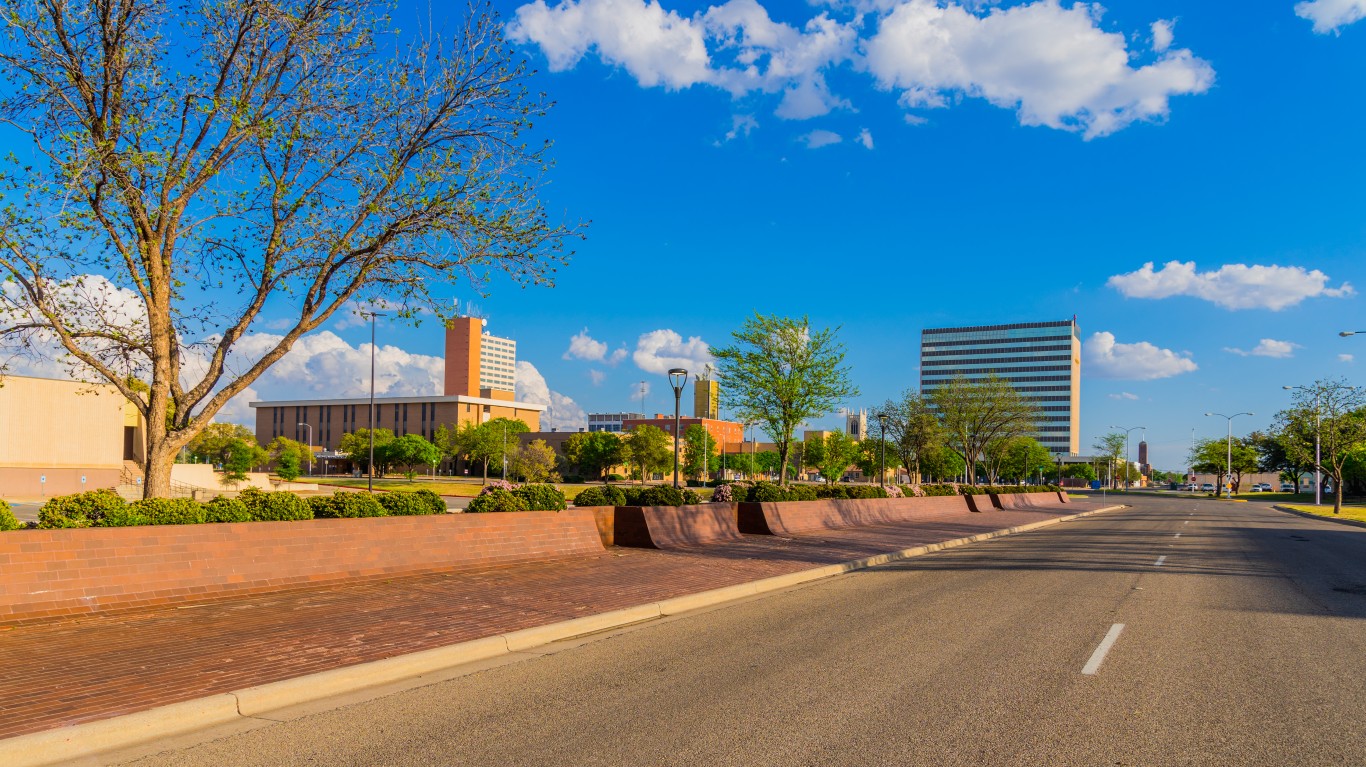
7. Lubbock, TX
> Year-over-year increase in homicide: +181.8% (+20)
> 2020 homicide rate: 9.5 per 100,000 people (31 total murders)
> 2019 homicide rate: 3.4 per 100,000 people (11 total murders)
> 2020 violent crime rate: 919 per 100,000 people (2,985 total)
> Population: 324,679
Lubbock, Texas reported a 182% increase in homicides in the last year, as reported murders in the metro area jumped from 11 in 2019 to 31 in 2020. As a result, the local homicide rate of 9.5 incidents per 100,000 people is now well above the 6.5 per 100,000 national rate, while in 2019, the metro area’s homicide rate of 3.4 per 100,000 was far below the 5.1 per 100,000 national rate that year.
Local officials connect the surge in deadly violence to drug use, firearms, and domestic violence.
[in-text-ad-2]
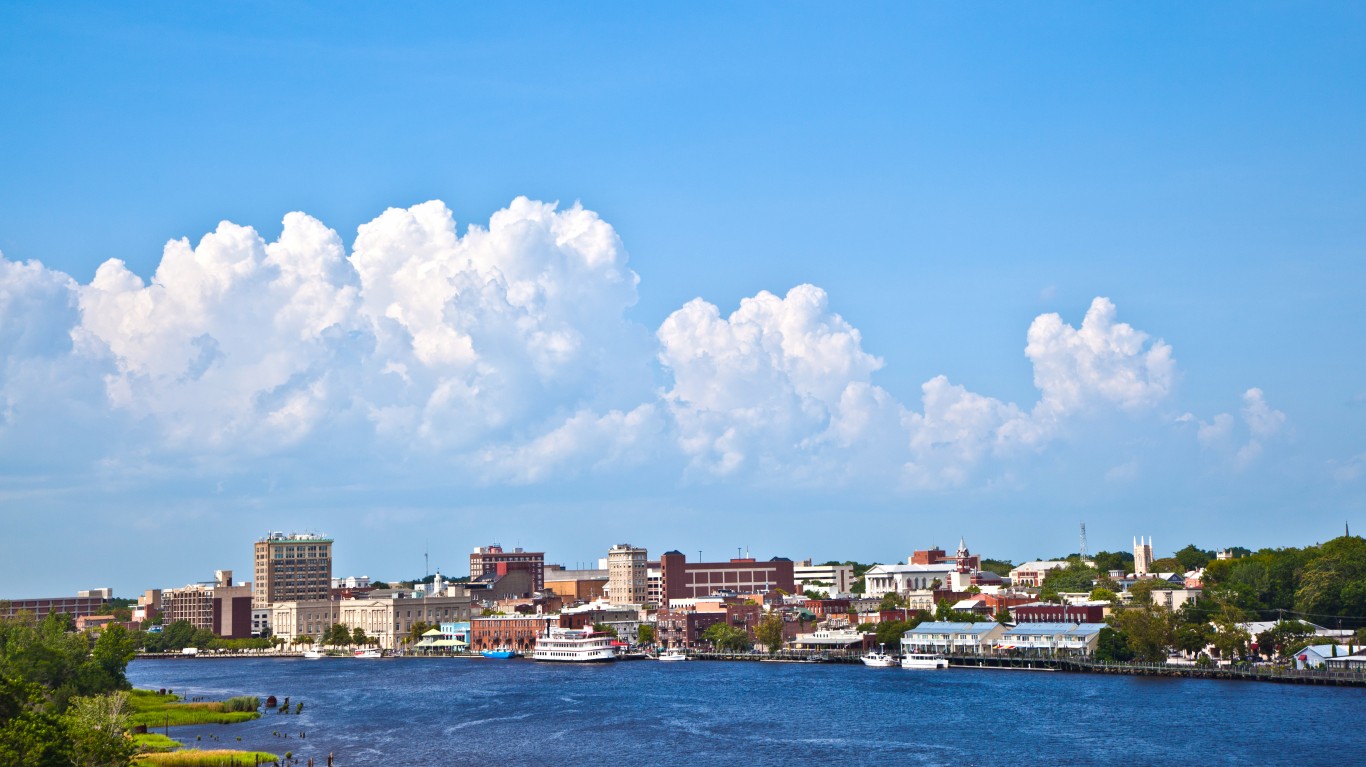
6. Wilmington, NC
> Year-over-year increase in homicide: +188.9% (+17)
> 2020 homicide rate: 8.6 per 100,000 people (26 total murders)
> 2019 homicide rate: 3.0 per 100,000 people (9 total murders)
> 2020 violent crime rate: 372 per 100,000 people (1,126 total)
> Population: 302,620
Wilmington, North Carolina, reported a 189% spike in homicides last year, the highest increase of any large metro area in the state and sixth highest nationwide. There were a total of 26 murders reported in the area in 2020, up from nine in 2019.
Despite the increase in homicides, the overall violent crime rate in Wilmington fell by 2.1% in 2020, following a decline in reported cases of sexual assault and aggravated assault. There were a total of 372 violent crimes for every 100,000 people in the Wilmington metro area in 2020, slightly below the U.S. rate of 388 per 100,000.

5. Sioux Falls, SD
> Year-over-year increase in homicide: +200.0% (+10)
> 2020 homicide rate: 5.5 per 100,000 people (15 total murders)
> 2019 homicide rate: 1.9 per 100,000 people (5 total murders)
> 2020 violent crime rate: 478 per 100,000 people (1,304 total)
> Population: 273,001
There were a total of 15 homicides reported in the Sioux Falls, South Dakota, metro area in 2020, triple the total murder count of five from 2019. Cases of reported robberies and aggravated assault also spiked in 2020, sending the metro area’s overall violent crime rate up 23.1% to 478 incidents per 100,000 people.
For Sioux Falls proper, 2020 will go down as the deadliest year so far in history. Much of the violence in the city last year was connected to drug trafficking.
[in-text-ad]

4. Greeley, CO
> Year-over-year increase in homicide: +220.0% (+11)
> 2020 homicide rate: 4.8 per 100,000 people (16 total murders)
> 2019 homicide rate: 1.6 per 100,000 people (5 total murders)
> 2020 violent crime rate: 324 per 100,000 people (1,074 total)
> Population: 331,283
Greeley, Colorado, is one of only four large U.S. metro areas where murders more than tripled in the last year. There were 16 homicides reported in the area in 2020, up 220% from five in 2019. Despite the increase, the local homicide rate of 4.8 per 100,000 people remains below the national rate of 6.5 per 100,000.
All other forms of violent crime also increased in Greeley last year, contributing to a near-nation leading 50% surge in the violent crime rate — nearly 10 times the nationwide increase. The Greeley chief of police attributes the spike to disruptions caused by the pandemic, including the release of some inmates from jails and prisons to improve social distancing measures within the facilities.
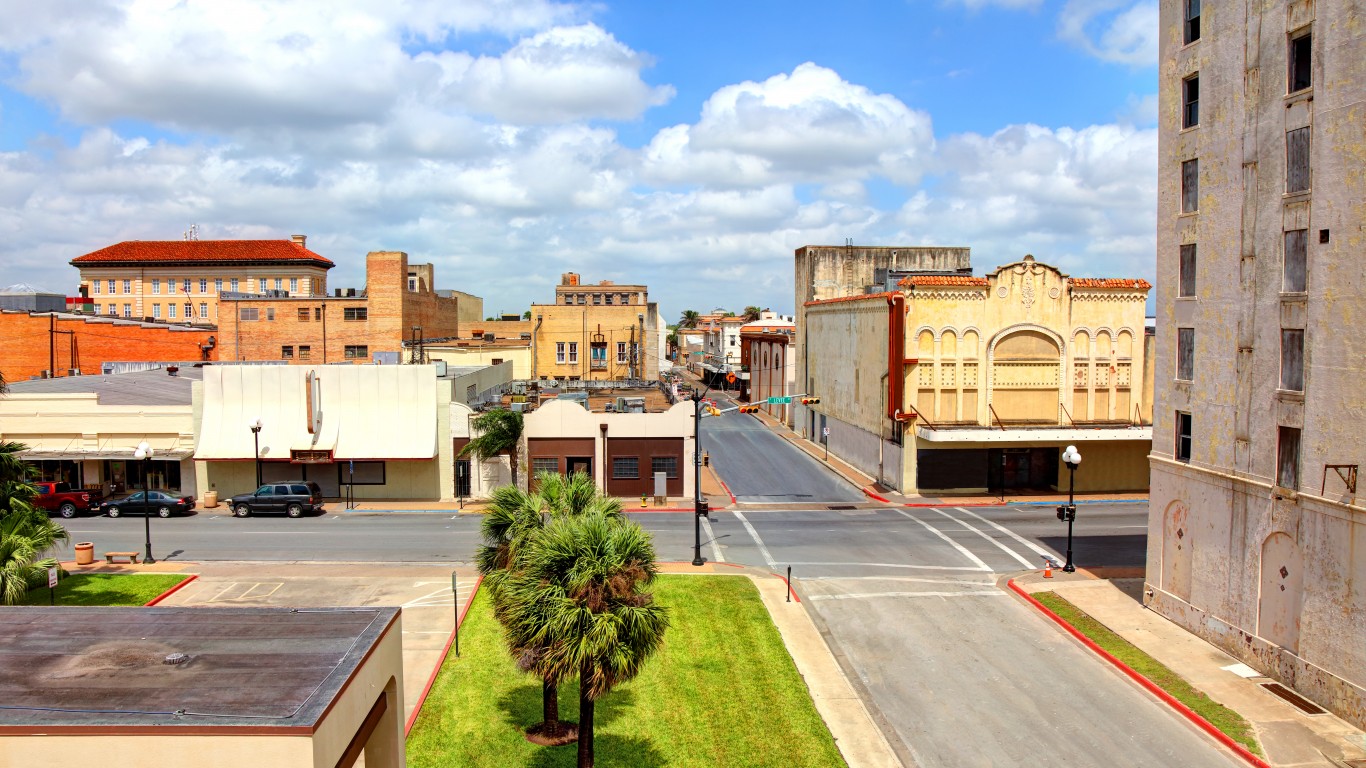
3. Brownsville-Harlingen, TX
> Year-over-year increase in homicide: +225.0% (+9)
> 2020 homicide rate: 3.1 per 100,000 people (13 total murders)
> 2019 homicide rate: 0.9 per 100,000 people (4 total murders)
> 2020 violent crime rate: 361 per 100,000 people (1,528 total)
> Population: 423,478
The Brownsville, Texas, metro area reported a 225% year-over-year spike in homicides, the worst of any large metro area in the state and third highest nationwide. There were 16 homicides reported in the area in 2020, up 220% from five in 2019. Despite the increase, the local homicide rate of 3.1 per 100,000 people remains below the national rate of 6.5 per 100,000.
Reports of other types of violent crime like aggravated assault and sexual assault declined in Brownsville in 2020, contributing to a 3.8% overall reduction in the violent crime rate. Including the 13 reported homicides, there were a total of 1,528 violent crimes in Brownsville in 2020 — or 361 for every 100,000 people, slightly below the U.S. rate of 388 per 100,000.
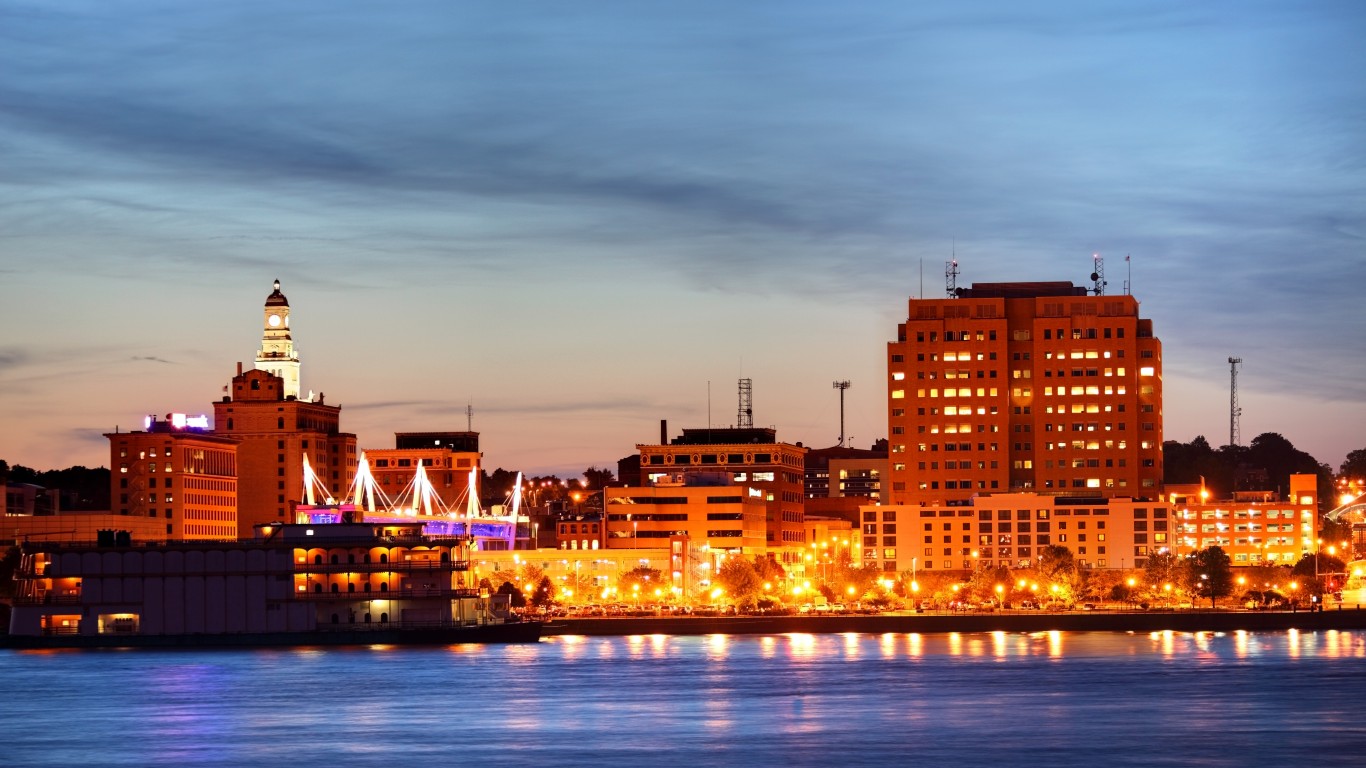
2. Davenport-Moline-Rock Island, IA-IL
> Year-over-year increase in homicide: +225.0% (+18)
> 2020 homicide rate: 6.9 per 100,000 people (26 total murders)
> 2019 homicide rate: 2.1 per 100,000 people (8 total murders)
> 2020 violent crime rate: 476 per 100,000 people (1,798 total)
> Population: 377,817
The Davenport-Moline-Rock Island metro area, which covers parts of Iowa and Illinois, reported a 225% surge in homicides last year, the second worst increase of the all large U.S. metro areas. As a result, the local homicide rate of 6.9 incidents per 100,000 people is now slightly higher than the 6.5 per 100,000 national rate, while in 2019, the metro area’s homicide rate of 2.1 per 100,000 was far below the 5.1 per 100,000 national rate that year.
While police in the city of Davenport have stepped up efforts to curb deadly violence by creating a Gun Crime Unit and adopting a database to better trace weapons used in crimes, they are also calling for a community based effort involving collaboration between the courts, community leaders, and police to prevent crime.
[in-text-ad-2]

1. Cedar Rapids, IA
> Year-over-year increase in homicide: +500.0% (+10)
> 2020 homicide rate: 4.4 per 100,000 people (12 total murders)
> 2019 homicide rate: 0.7 per 100,000 people (2 total murders)
> 2020 violent crime rate: 252 per 100,000 people (691 total)
> Population: 274,312
Cedar Rapids, Iowa, reported a 500% surge in homicides year over year, by far the highest increase of any large U.S. metro area. There were a total of 12 murders reported in the metro area in 2020, up from two the previous year. Despite the worst-in-the-nation increase, the local murder rate of 4.4 for every 100,000 people remains below the U.S. rate of 6.5 per 100,000 people.
The majority of homicide victims in the city last year were under age 30. City police officials attribute the spike, in part, to the pandemic, which sent unemployment soaring and exacerbated certain stressors that are tied to violent crime. Joblessness in the Cedar Rapids metro area more than doubled from 3.0% in 2019 to 6.2% in 2020.
Methodology
To identify the cities where homicide is soaring, 24/7 Wall St. reviewed FBI crime data at the metropolitan area level for 2020. Metro areas are ranked on the percent increase in total murders from 2019 to 2020. In the case of a tie, the metro area with the largest percent increase in the murder rate is ranked higher. Only metro areas with populations of at least 250,000 residents and at least one homicide in 2019 were considered.
Cash Back Credit Cards Have Never Been This Good
Credit card companies are at war, handing out free rewards and benefits to win the best customers. A good cash back card can be worth thousands of dollars a year in free money, not to mention other perks like travel, insurance, and access to fancy lounges. See our top picks for the best credit cards today. You won’t want to miss some of these offers.
Flywheel Publishing has partnered with CardRatings for our coverage of credit card products. Flywheel Publishing and CardRatings may receive a commission from card issuers.
Thank you for reading! Have some feedback for us?
Contact the 24/7 Wall St. editorial team.
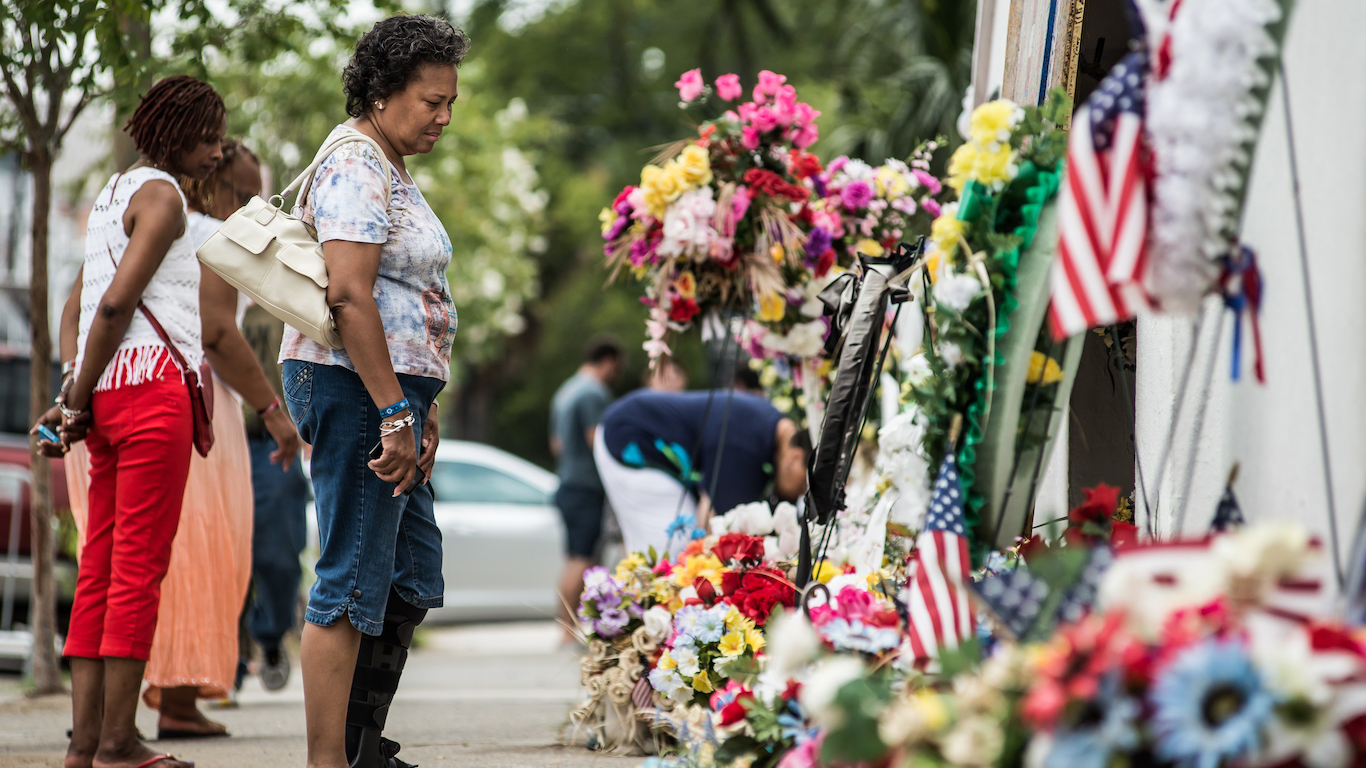 24/7 Wall St.
24/7 Wall St. 24/7 Wall St.
24/7 Wall St.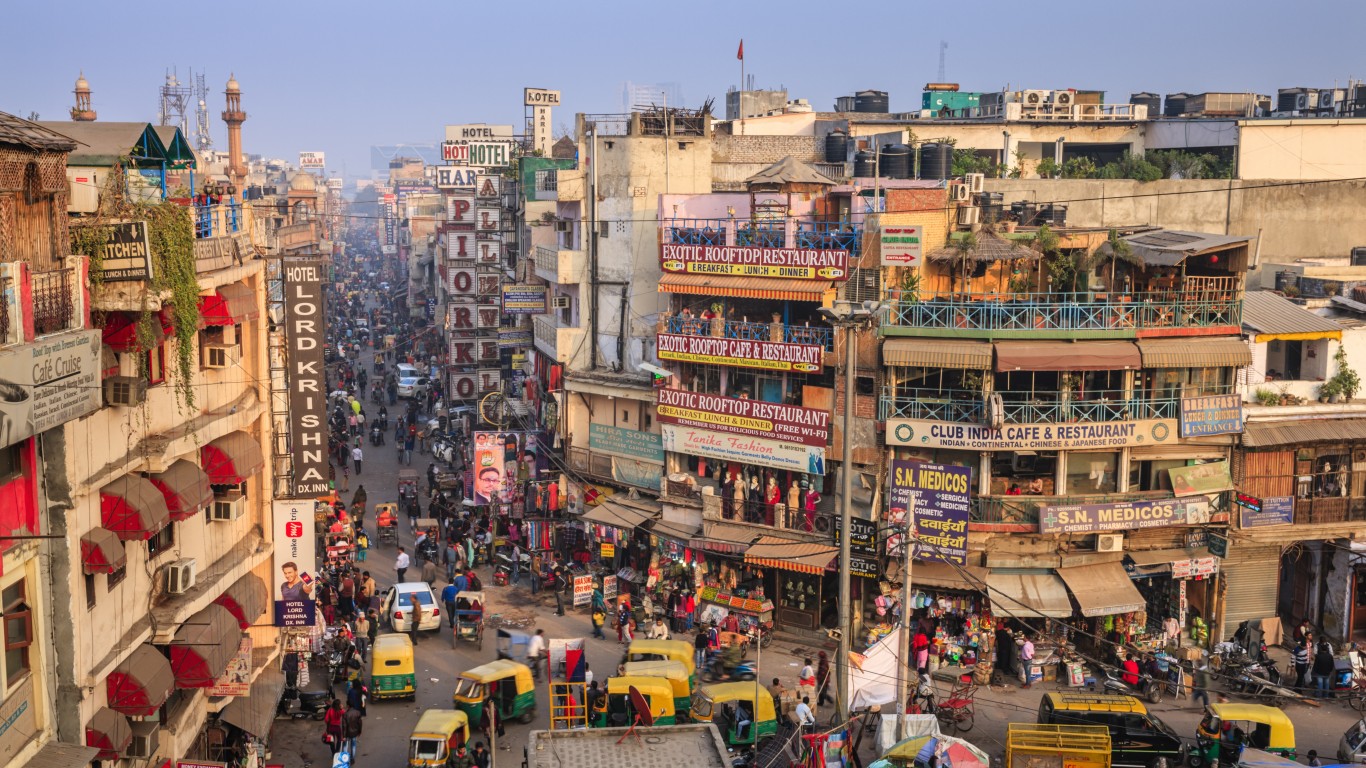 24/7 Wall St.
24/7 Wall St. 24/7 Wall St.
24/7 Wall St.
